Update on Wnt signaling in bone cell biology and bone disease
- 格式:pdf
- 大小:870.88 KB
- 文档页数:18
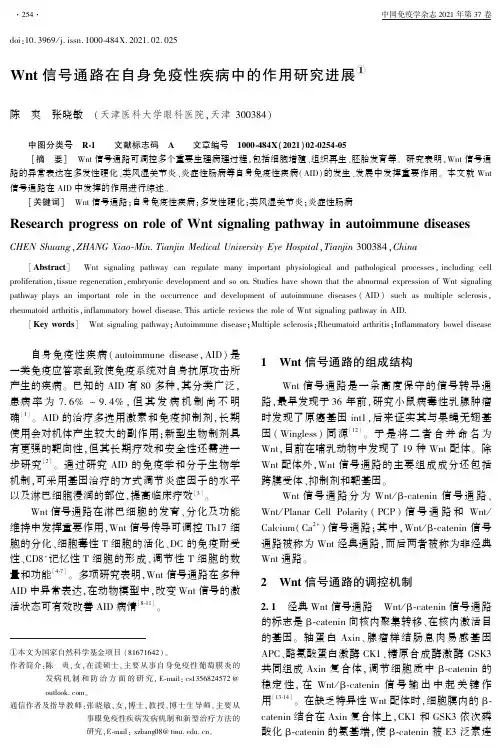
doi:10.3969/j.issn.1000⁃484X.2021.02.025Wnt 信号通路在自身免疫性疾病中的作用研究进展①陈 爽 张晓敏 (天津医科大学眼科医院,天津300384) 中图分类号 R⁃1 文献标志码 A 文章编号 1000⁃484X (2021)02⁃0254⁃05①本文为国家自然科学基金项目(81671642)㊂作者简介:陈 爽,女,在读硕士,主要从事自身免疫性葡萄膜炎的发病机制和防治方面的研究,E⁃mail:cs1356824572@㊂通信作者及指导教师:张晓敏,女,博士,教授,博士生导师,主要从事眼免疫性疾病发病机制和新型治疗方法的研究,E⁃mail:xzhang08@㊂[摘 要] Wnt 信号通路可调控多个重要生理病理过程,包括细胞增殖㊁组织再生㊁胚胎发育等㊂研究表明,Wnt 信号通路的异常表达在多发性硬化㊁类风湿关节炎㊁炎症性肠病等自身免疫性疾病(AID)的发生㊁发展中发挥重要作用㊂本文就Wnt 信号通路在AID 中发挥的作用进行综述㊂[关键词] Wnt 信号通路;自身免疫性疾病;多发性硬化;类风湿关节炎;炎症性肠病Research progress on role of Wnt signaling pathway in autoimmune diseasesCHEN Shuang ,ZHANG Xiao⁃Min .Tianjin Medical University Eye Hospital ,Tianjin 300384,China[Abstract ] Wnt signaling pathway can regulate many important physiological and pathological processes,including cellproliferation,tissue regeneration,embryonic development and so on.Studies have shown that the abnormal expression of Wnt signaling pathway plays an important role in the occurrence and development of autoimmune diseases (AID)such as multiple sclerosis,rheumatoid arthritis,inflammatory bowel disease.This article reviews the role of Wnt signaling pathway in AID.[Key words ] Wnt signaling pathway;Autoimmune disease;Multiple sclerosis;Rheumatoid arthritis;Inflammatory bowel disease 自身免疫性疾病(autoimmune disease,AID)是一类免疫应答紊乱致使免疫系统对自身抗原攻击所产生的疾病㊂已知的AID 有80多种,其分类广泛,患病率为7.6%~9.4%,但其发病机制尚不明确[1]㊂AID 的治疗多选用激素和免疫抑制剂,长期使用会对机体产生较大的副作用;新型生物制剂具有更强的靶向性,但其长期疗效和安全性还需进一步研究[2]㊂通过研究AID 的免疫学和分子生物学机制,可采用基因治疗的方式调节炎症因子的水平以及淋巴细胞浸润的部位,提高临床疗效[3]㊂Wnt 信号通路在淋巴细胞的发育㊁分化及功能维持中发挥重要作用,Wnt 信号传导可调控Th17细胞的分化㊁细胞毒性T 细胞的活化㊁DC 的免疫耐受性㊁CD8+记忆性T 细胞的形成㊁调节性T 细胞的数量和功能[4⁃7]㊂多项研究表明,Wnt 信号通路在多种AID 中异常表达,在动物模型中,改变Wnt 信号的激活状态可有效改善AID 病情[8⁃11]㊂1 Wnt 信号通路的组成结构Wnt 信号通路是一条高度保守的信号转导通路,最早发现于36年前,研究小鼠病毒性乳腺肿瘤时发现了原癌基因int1,后来证实其与果蝇无翅基因(Wingless)同源[12]㊂于是将二者合并命名为Wnt,目前在哺乳动物中发现了19种Wnt 配体㊂除Wnt 配体外,Wnt 信号通路的主要组成成分还包括跨膜受体㊁抑制剂和靶基因㊂Wnt 信号通路分为Wnt /β⁃catenin 信号通路㊁Wnt /Planar Cell Polarity (PCP )信号通路和Wnt /Calcium(Ca 2+)信号通路;其中,Wnt /β⁃catenin 信号通路被称为Wnt 经典通路,而后两者被称为非经典Wnt 通路㊂2 Wnt 信号通路的调控机制2.1 经典Wnt 信号通路 Wnt /β⁃catenin 信号通路的标志是β⁃catenin 向核内聚集转移㊁在核内激活目的基因㊂轴蛋白Axin㊁腺瘤样结肠息肉易感基因APC㊁酪氨酸蛋白激酶CK1㊁糖原合成酶激酶GSK3共同组成Axin 复合体,调节细胞质中β⁃catenin 的稳定性,在Wnt /β⁃catenin 信号输出中起关键作用[13⁃14]㊂在缺乏特异性Wnt 配体时,细胞膜内的β⁃catenin 结合在Axin 复合体上,CK1和GSK3依次磷酸化β⁃catenin 的氨基端,使β⁃catenin 被E3泛素连㊃452㊃中国免疫学杂志2021年第37卷接酶亚基β⁃Trcp识别,随后β⁃catenin被泛素化并降解[13⁃14]㊂当Wnt配体与跨膜蛋白Frizzled(Fzd)受体和共受体低密度脂蛋白受体相关蛋白LRP6结合,形成类似于Wnt⁃Fz⁃LRP6的复合体时,Wnt/β⁃catenin信号通路被激活;同时招募支架蛋白Dishevelled(Dvl),导致LRP6磷酸化并活化,Axin复合体与磷酸化的LRP6结合;同时Axin复合体介导的β⁃catenin磷酸化被抑制,β⁃catenin稳定聚集并转移进入细胞核,同TCF/LEF结合形成复合体,激活Wnt下游靶基因转录表达[13⁃14]㊂2.2 非经典Wnt信号通路 Wnt/Ca2+信号通路是通过磷脂酶介导的,导致细胞内游离钙离子瞬时增加,进而激活蛋白激酶PKC和钙调蛋白介导的蛋白激酶CaMKⅡ,促进活化T细胞核因子NFAT的转录过程㊁阻断β⁃catenin信号通路或参与细胞黏附等[15]㊂Wnt配体与Fzd受体结合,和共受体Ror1/2相互作用,膜结合酶PLC使膜结合型磷脂酰肌醇二膦酸脂产生肌醇三磷酸IP3和二酰基甘油DAG,而Dvl㊁Axin和GSK组成Dvl⁃Axin⁃GSK三联复合体,介导共受体Ror的磷酸化㊂IP3引起内质网释放Ca2+,随后Cn和CaMKⅡ被激活,进而分别激活NFAT和NFκB;DAG被内质网释放的Ca2+激活,随后激活PKC,进而激活NFκB和CREB;NFAT㊁NFκB和CREB转移入核并转录下游基因[15]㊂Wnt/PCP信号通路的核心分子包括Fzd㊁Van Gogh(Vang)㊁Dvl㊁Prickle和Diego,在细胞内形成Fzd⁃Dvl⁃Diego⁃stan复合体和Vang⁃Prickle复合体,其中Diego连接Dvl正向调节Wnt/PCP信号通路,而Prickle通过阻断两者的连接负向调节Wnt/PCP信号[16⁃17]㊂Wnt/PCP信号通路导致GTP酶RhoA和Rac1的激活,从而激活氨基末端激酶JNK和Rho相关的蛋白激酶ROCK,并导致细胞骨架的重塑㊁细胞黏附和运动的改变[16⁃17]㊂3 Wnt信号通路与AIDWnt信号通路在淋巴细胞的增殖分化,以及功能维持中发挥重要作用㊂Wnt信号通路调节胸腺和外周淋巴组织中T细胞的发育和分化过程,在T细胞分化的任何阶段,该途径的功能障碍可导致严重的自身免疫,包括实验性自身免疫性脑脊髓炎或免疫缺陷[18]㊂Wnt信号可以调控DC引起强大的调节性T细胞反应,Wnt信号通路代表抗原提呈细胞抑制过度炎症的分子开关,从而保护宿主免受免疫介导的病理损伤[19]㊂在多种AID中,Wnt信号存在异常表达㊂3.1 Wnt信号通路与多发性硬化(multiple scler⁃osis,MS) MS是一种中枢神经系统(central nervous system,CNS)脱髓鞘疾病,其特征在于髓鞘丢失和神经元变性㊂实验性自身免疫性脑脊髓炎(experimental autoimmune encephalomyelitis,EAE)的小鼠已被广泛用于模拟MS相关的神经系统并发症,包括CNS脱髓鞘㊁神经炎症和运动损伤㊂SCHNEIDER等[20]检测了EAE小鼠脊髓中Wnt信号蛋白的表达,发现Wnt信号通路在脊髓中显著上调,且Wnt信号通路的异常激活有助于EAE相关慢性疼痛的进展㊂随后,LENGFELD等[21]发现在人MS和小鼠EAE模型的CNS内皮细胞中,经典Wnt 信号通路上调㊂通过Wnt信号转导报告小鼠Axin2 (LacZ),SCHNEIDER等[20]还发现Wnt信号传导的增强可能支持神经源过程以应对免疫介导的神经炎症时的神经元缺陷㊂最近有一项研究证明,中枢神经系统脱髓鞘后,脱髓鞘白质内的离散生态位中形成的独特微环境决定了少突胶质前体细胞OPCs分化为再生髓鞘少突胶质细胞OLs还是再生髓鞘雪旺细胞SCs[22]㊂通过转录组图谱比较,这一生态位富含骨形态发生蛋白(bone morphogenetic proteins, BMPs)和Wnt信号通路的分泌配体,这些配体由激活的OPCs和内皮细胞产生;而非血管区的反应性星形胶质细胞表达BMP/Wnt的双重拮抗剂Sostdc1[22]㊂血脑屏障(blood brain barrier,BBB)的破坏是MS的一个明确而早期的特征,它直接损害CNS,促进免疫细胞浸润,并影响临床疗效㊂在EAE/MS中,CNS血管中活化的Wnt/β⁃catenin信号恢复了部分BBB的功能,限制了免疫细胞向中枢神经系统的浸润[21]㊂全基因组关联研究显示,单核苷酸多态性rs1335532的微小变异与MS的低风险相关,保护性的rs1335532等位基因为Wnt信号通路的靶基因ASCL2转录因子创造了功能结合位点;在保护性的rs1335532等位基因存在的情况下,Wnt信号通路的激活导致CD58启动子活性增加,CD58结合CD2受体刺激调节性T细胞,发挥对MS的保护作用[23]㊂Wnt信号通路在MS中显著上调,发挥保护作用㊂3.2 Wnt信号通路与类风湿关节炎(rheumatoid arthritis,RA) RA是一种病因不明的对称性多关节AID,目前认为是由类风湿因子和抗瓜氨酸肽抗体ACPA2种已知抗体引起的,其特征是滑膜炎症和增殖㊁伴有软骨侵蚀和骨丢失,临床表现为持续的滑膜炎症㊁关节炎症和关节破坏[24⁃25]㊂成纤维细胞样滑膜细胞(fibroblast⁃like synoviocytes,FLS)在RA㊃552㊃陈 爽等 Wnt信号通路在自身免疫性疾病中的作用研究进展 第2期的发病机制中发挥重要作用,而β⁃catenin信号通路有助于RA中FLS的稳定活化㊂Wnt拮抗剂Dickkopf⁃1(DKK⁃1)是FLS在炎症中分泌的,该蛋白被认为是RA成骨细胞⁃破骨细胞轴失衡的主要调节因子[26]㊂通过荟萃分析评估发现,RA患者血清DKK⁃1水平较健康对照组升高,表明DKK⁃1在RA 的发病机制和治疗中具有重要作用[27]㊂肿瘤坏死因子生物抑制剂的治疗会迅速降低RA患者血清中DKK⁃1水平,减少骨吸收㊁增加骨形成[28]㊂Wnt信号通路拮抗剂的过度分泌导致成骨细胞的分化和功能受损,破坏骨侵蚀的修复能力㊂另一项研究通过Wnt5a敲除小鼠检测内源性Wnt5a对于关节的影响,结果显示Wnt5a敲除小鼠对关节炎发展具有抗性㊁Wnt5a通过促进炎症和破骨细胞融合来调节关节炎的发展[9]㊂胶原溶解基质金属蛋白酶MMP1和MMP13对软骨胶原的不可逆破坏是与关节炎等组织破坏相关的病理过程中的一个关键因素,而炎症诱导的活化蛋白⁃1(activator protein⁃1,AP⁃1)转录因子是MMP1和MMP13基因的重要调节因子㊂MACDONALD等[29]已经证明CFOs与近端MMP1启动子内的AP⁃1顺式元件结合,CFOs对MMP1的表达有显著的促进作用,而沉默Wnt相关的富含半胱氨酸的核蛋白CSRNP1导致MMP1的大量抑制; DNA结合分析表明,CSRNP1选择性地促进人软骨细胞MMP1地表达,减弱炎症组织损伤㊂3.3 Wnt信号通路与炎症性肠病(inflammatory bowel disease,IBD) IBD是一种胃肠道衰弱疾病,主要包括克罗恩病(crohn′s disease,CD)和溃疡性结肠炎(ulcerative colitis,UC)[30]㊂IBD的病因尚不明确,以腹痛㊁腹泻㊁肠梗阻㊁肠穿孔等为主要临床表现,以肠黏膜慢性反复发炎㊁引起血性腹泻和严重腹痛等为主要特征,反复的组织损伤和修复最终导致黏膜功能的丧失,并可能引发结肠炎相关癌症[31]㊂CD的特点是Paneth细胞产生的抗菌α⁃防御素的特异性减少和黏膜黏附菌的存在,UC的特点是结肠黏液层缺陷和杯状细胞数量减少[32⁃33]㊂小鼠中Dkk⁃1的全身性表达导致Wnt靶基因的表达迅速被抑制,小肠和结肠的增殖受到抑制,说明Wnt是成人小肠和结肠的重要生长因子[34]㊂在小鼠Tcf⁃4基因敲除模型中,Tcf⁃4在杂合子小鼠中表达的降低足以引起Paneth细胞α⁃防御素水平和细菌杀伤活性的显著降低,导致CD的产生[32]㊂炎症性肠病相关大肠癌的全基因组测序分析显示,在IBD患者的肿瘤中,SOX9和EP300的突变频率更高或更独特;还揭示了GTP酶RhoA和Rac1成分的重复突变,表明Wnt信号通路在IBD大肠肿瘤的发生中发挥了作用[35]㊂WISP1是分泌的基质细胞蛋白,在IBD中增加并且有助于肠道中的促炎性级联反应,可以调节Wnt/β⁃catenin途径[36]㊂WiF⁃1是Wnt信号通路的一种抑制蛋白,在CD和UC的活检组织中,WiF⁃1的表达明显增强[37]㊂IBD小鼠中miRNA31表达量增加,调节Wnt和Hippo信号通路促进上皮再生,免疫反应减弱,减轻炎症程度[38]㊂调节性T细胞中β⁃catenin的稳定表达提高了调节性T细胞的存活率,并诱导了非调节性T细胞无应答[39]㊂在IBD模型小鼠中,阻断DC中β⁃catenin的表达增强了炎症反应和疾病,β⁃catenin使DC处于耐受状态,限制了炎症反应[40]㊂3.4 Wnt信号通路与其他AID 系统性红斑狼疮(system lupus erythematosus,SLE)是一种病因不明的慢性AID,其特征是多种免疫异常,包括丧失对自身抗原的免疫耐受㊁异常淋巴细胞活化和自身抗体产生;miRNA分析发现潜在靶基因主要富集于发育过程,且参与调控Wnt信号通路[41]㊂白癜风是最常见的人类色素性疾病,其特征在于成熟的表皮黑色素细胞的进行性自身免疫性破坏,Wnt/β⁃catenin在不同色素沉着系统中具有增殖㊁迁移和分化作用[42]㊂在黑色素瘤患者中,长链非编码BANCR普遍存在高表达,可通过激活Wnt/β⁃catenin信号通路调控黑色素瘤细胞迁移和侵袭能力[43]㊂系统性硬化症(systemic sclerosis,SSc)是一种自身免疫性结缔组织病,导致皮肤纤维化㊂有研究表明,Wnt/β⁃catenin信号通路在SSc小鼠的皮肤和肺中过度活化[44]㊂甲基帽结合蛋白MeCP2通过Wnt拮抗剂sFRP1的表观遗传抑制积极调节细胞外基质的表达,导致增强的Wnt信号传导,启动和驱动SSc中成纤维细胞活化[45]㊂在结缔组织病相关的肺间质病变(CTD⁃ILD)中,下调Wnt/β⁃catenin信号通路可降低CTD⁃ILD纤维化的发生[46]㊂马复发性葡萄膜炎是马中严重且常见的致盲疾病,其呈现自身反应性侵入性T细胞,导致内眼破坏㊂HAUCK等[10]发现补体和凝血级联的显著上调和经典Wnt信号传导的负旁分泌调节剂的下调,包括Wnt抑制剂DKK3和SFRP2㊂4 结语综上所述,Wnt信号通路在AID的发生发展中发挥重要作用,但具体机制有待进一步研究㊂AID常因病因不明给治疗带来困扰,探索针对Wnt信号通路的新的治疗靶点,将为AID的诊治提供新方向㊂㊃652㊃中国免疫学杂志2021年第37卷参考文献:[1] COOPER G S,BYNUM M L,SOMERS E C.Recent insights in theepidemiology of autoimmune diseases:improved prevalence estimates and understanding of clustering of diseases[J].J Autoimmun,2009,33(3⁃4):197⁃207.DOI:10.1016/ j.jaut.2009.09.008.[2] WOLFE R M,ANG D C.Biologic therapies for autoimmune andconnective tissue diseases[J].Immunol Allergy Clin North Am, 2017,37(2):283⁃299.DOI:10.1016/j.iac.2017.01.005. [3] SHU S A,WANG J,TAO M H,et al.Gene therapy for autoimmunedisease[J].Clin Rev Allergy Immunol,2015,49(2):163⁃176.DOI:10.1007/s12016⁃014⁃8451⁃x.[4] XIAO Z,SUN Z,SMYTH K,et al.Wnt signaling inhibits CTLmemory programming[J].Mol Immunol,2013,56(4):423⁃433.DOI:10.1016/j.molimm.2013.06.008.[5] SWAFFORD D,MANICASSAMY S.Wnt signaling in dendriticcells:Its role in regulation of immunity and tolerance[J].Discov Med,2015,19(105):303⁃310.DOI:10.3389/fimmu.2020.00122.[6] XUE H H,Zhao D M.Regulation of mature T cell responses by theWnt signaling pathway[J].Ann N Y Acad Sci,2012,1247:16⁃33.DOI:10.1111/j.1749⁃6632.2011.06302.x.[7] WEI F,ZHANG Y,ZHAO W,et al.Progranulin facilitatesconversion and function of regulatory T cells under inflammatory conditions[J].PLoS One,2014,9(11):e112110.DOI:10.1371/ journal.pone.0112110.[8] GIACOPPO S,SOUNDARA Rajan T,DE Nicola G R,et al.Moringin activates Wnt canonical pathway by inhibiting GSK3beta in a mouse model of experimental autoimmune encephalomyelitis [J].Drug Des Devel Ther,2016,10:3291⁃3304.DOI:10.2147/ DDDT.S110514.[9] MACLAUCHLAN S,ZURIAGA M A,FUSTER J J,et al.Geneticdeficiency of Wnt5a diminishes disease severity in a murine model of rheumatoid arthritis[J].Arthritis Res Ther,2017,19(1): 166.DOI:10.1186/s13075⁃017⁃1375⁃0.[10] HAUCK S M,HOFMAIER F,DIETTER J,et bel⁃free LC⁃MSMS analysis of vitreous from autoimmune uveitis reveals asignificant decrease in secreted Wnt signalling inhibitors DKK3and SFRP2[J].J Proteomics,2012,75(14):4545⁃4554.DOI:10.1016/j.jprot.2012.04.052.[11] SORCINI D,BRUSCOLI S,FRAMMARTINO T,et al.Wnt/beta⁃catenin signaling induces integrin alpha4beta1in T cells andpromotes a progressive neuroinflammatory disease in mice[J].JImmunol,2017,199(9):3031⁃3041.DOI:10.4049/jimmu⁃nol.1700247.[12] RIJSEWIJK F,SCHUERMANN M,WAGENAAR E,et al.Thedrosophila homolog of the mouse mammary oncogene int⁃1isidentical to the segment polarity gene wingless[J].Cell,1987,50(4):649⁃657.DOI:10.1016/0092⁃8674(87)90038⁃9. [13] MACDONCALD B T,TAMAI K,HE X.Wnt/beta⁃cateninsignaling:components,mechanisms,and diseases[J].Dev Cell,2009,17(1):9⁃26.DOI:10.1016/j.devcel.2009.06.016. [14] CLEVERS H,NUSSE R.Wnt/beta⁃catenin signaling and disease[J].Cell,2012,149(6):1192⁃1205.DOI:10.1016/j.cell.2012.05.012.[15] DE A.Wnt/Ca2+signaling pathway:A brief overview[J].ActaBiochim Biophys Sin(Shanghai),2011,43(10):745⁃756.DOI:10.1093/abbs/gmr079.[16] KATOH M.Wnt/PCP signaling pathway and human cancer(review)[J].Oncol Rep,2005,14(6):1583⁃1588. [17] HUMPHRIES A C,MLODZIK M.From instruction to output:Wnt/PCP signaling in development and cancer[J].Curr OpinCell Biol,2018,51:110⁃116.DOI:10.1016/j.ceb.2017.12.005.[18] MA J,WANG R,FANG X,et al.Beta⁃catenin/TCF⁃1pathway inT cell development and differentiation[J].J NeuroimmunPharmacol,2012,7(4):750⁃762.DOI:10.1007/s11481⁃012⁃9367⁃y.[19] SURYAWANSHI A,TADAGAVADI R K,SWAFFOR D,et al.Modulation of inflammatory responses by Wnt/beta⁃cateninsignaling in dendritic cells:A novel immunotherapy target for au⁃toimmunity and cancer[J].Front Immunol,2016,7:460.DOI:10.3389/fimmu.2016.00460.[20] SCHNEIDER R,KOOP B,SCHROTER F,et al.Activation ofWnt signaling promotes hippocampal neurogenesis in experime⁃ntal autoimmune encephalomyelitis[J].Mol Neurodegener,2016,11(1):53.DOI:10.1186/s13024⁃016⁃0117⁃0. [21] LENGFELD J E,LUTZ S E,SMITH J R,et al.Endothelial Wnt/beta⁃catenin signaling reduces immune cell infiltration in multiplesclerosis[J].Proc Natl Acad Sci U S A,2017,114(7):E1168⁃E1177.DOI:10.1073/pnas.1609905114.[22] ULANSKA⁃POUTANEN J,MIECZKOWSKI J,ZHAO C,et al.Injury⁃induced perivascular niche supports alternativedifferentiation of adult rodent CNS progenitor cells[J].Elife,2018,7.DOI:10.7554/eLife.30325.[23] MITKIN N A,MURATOVA A M,KORNEEV K V,et al.Protective C allele of the single⁃nucleotide polymorphismrs1335532is associated with strong binding of Ascl2transcriptionfactor and elevated CD58expression in B⁃cells[J].BiochimBiophys Acta Mol Basis Dis,2018,1864(10):3211⁃3220.DOI:10.1016/j.bbadis.2018.07.008.[24] BOISSIER M C,SEMERANO L,CHALLAL S,et al.Rheumatoidarthritis:From autoimmunity to synovitis and joint destruction[J].J Autoimmun,2012,39(3):222⁃228.DOI:10.1016/j.jaut.2012.05.021.[25] MIAO C G,YANG Y Y,HE X,et al.Wnt signaling pathway inrheumatoid arthritis,with special emphasis on the different rolesin synovial inflammation and bone remodeling[J].Cell Signal,2013,25(10):2069⁃2078.DOI:10.1016/j.cellsig.2013.04.002.[26] DIARRA D,STOLINA M,POLZER K,et al.Dickkopf⁃1is amaster regulator of joint remodeling[J].Nat Med,2007,13(2):156⁃163.DOI:10.1038/nm1538.[27] MA Y,ZHANG X,WANG M,et al.The serum level of Dickkopf⁃1in patients with rheumatoid arthritis:A systematic review andmeta⁃analysis[J].Int Immunopharmacol,2018,59:227⁃陈 爽等 Wnt信号通路在自身免疫性疾病中的作用研究进展 第2期232.DOI:10.1016/j.intimp.2018.04.019.[28] FASSIO A,ADAMI G,GATTI D,et al.Inhibition of tumornecrosis factor⁃alpha(TNF⁃alpha)in patients with earlyrheumatoid arthritis results in acute changes of bone modulators[J].Int Immunopharmacol,2019,67:487⁃489.DOI:10.1016/j.intimp.2018.12.050.[29] MACDONALD C D,FALCONER A M D,CHAN C M,et al.Cyto⁃kineinduced cysteine⁃serine⁃rich nuclear protein⁃1(CSRNP1)selectively contributes to MMP1expression in human chondrocytes[J].PLoS One,2018,13(11):e0207240.DOI:10.1371/journal.pone.0207240.[30] MOPARTHI L,KOCH S.Wnt signaling in intestinal inflammation[J].Differentiation,2019.DOI:10.1016/j.diff.2019.01.002.[31] ULLMAN T A,ITZKOWITZ S H.Intestinal inflammation andcancer[J].Gastroenterology,2011,140(6):1807⁃1816.DOI:10.1053/j.gastro.2011.01.057.[32] WEHKAMP J,WANG G,KUBLER I,et al.The paneth cellalpha⁃defensin deficiency of ileal Crohn′s disease is linked toWnt/Tcf⁃4[J].J Immunol,2007,179(5):3109⁃3118.DOI:10.4049/jimmunol.179.5.3109.[33] GERSEMANN M,BECKER S,KUBLER I,et al.Differences ingoblet cell differentiation between Crohn′s disease and ulcerativecolitis[J].Differentiation,2009,77(1):84⁃94.DOI:10.1016/j.diff.2008.09.008.[34] HOFFMAN J,KUHNERT F,DAVIS C R,et al.Wnts as essentialgrowth factors for the adult small intestine and colon[J].CellCycle,2004,3(5):554⁃557.[35] ROBLES A I,TRAVERSO G,ZHANG M,et al.Whole⁃exome se⁃quencing analyses of inflammatory bowel disease⁃associatedcolorectal cancers[J].Gastroenterology,2016,150(4):931⁃943.DOI:10.1053/j.gastro.2015.12.036.[36] ZHANG Q,ZHANG C,LI X,et al.WISP1is increased inintestinal mucosa and contributes to inflammatory cascades in in⁃flammatory bowel disease[J].Dis Markers,2016.DOI:10.1155/2016/3547096.[37] TERRY R,CHINTANABOINA J,PATEL D,et al.Expression ofWIF⁃1in inflammatory bowel disease[J].Histol Histopathol,2019,34(2):149⁃157.DOI:10.14670/HH⁃18⁃031. [38] TIAN Y,XU J,LI Y,et al.MicroRNA⁃31reduces inflammatorysignaling and promotes regeneration in colon epithelium,anddelivery of mimics in microspheres reduces colitis in mice[J].Gastroenterology,2019.DOI:10.1053/j.gastro.2019.02.023.[39] DING Y,SHEN S,LINO A C,et al.Beta⁃catenin stabilizationextends regulatory T cell survival and induces anergy innonregulatory T cells[J].Nat Med,2008,14(2):162⁃169.DOI:10.1038/nm1707.[40] MANICASSAMY S,REIZIS B,RAVINDRAN R,et al.Activationof beta⁃catenin in dendritic cells regulates immunity versustolerance in the intestine[J].Science,2010,329(5993):849⁃853.DOI:10.1126/science.1188510.[41] LIU D,ZHAO H,ZHAO S,et al.MicroRNA expression profiles ofperipheral blood mononuclear cells in patients with systemic lupuserythematosus[J].Acta Histochem,2014,116(5):891⁃897.DOI:10.1016/j.acthis.2014.02.009.[42] BIRLEA S A,COSTIN G E,ROOP D R,et al.Trends inregenerative medicine:Repigmentation in vitiligo throughmelanocyte stem cell mobilization[J].Med Res Rev,2017,37(4):907⁃935.DOI:10.1002/med.21426.[43] 杨晓静,孟 玮,徐宏俊,等.长链非编码BANCR通过激活Wnt/β⁃catenin信号通路调控黑色素瘤细胞迁移和侵袭行为[J].中国免疫学杂志,2018,34(1):50⁃54,59.DOI:10.3969/j.issn.1000⁃484X.2018.01.010.[44] MORIN F,KAVIAN N,NICCO C,et al.Niclosamide preventssystemic sclerosis in a reactive oxygen species⁃induced mousemodel[J].J Immunol,2016,197(8):3018⁃3028.DOI:10.4049/jimmunol.1502482.[45] HENDERSON J,BROWN M,HORSBURGH S,et al.Methyl capbinding protein2:A key epigenetic protein in systemic sclerosis[J].Rheumatology(Oxford),2018.DOI:10.1093/rheumatology/key327.[46] 岳彩芳,付冰冰,骆 鹏.TGFBR1基因调控Wnt/β⁃catenin信号通路对结缔组织病相关的肺间质病变中抗纤维化的机制研究[J].中国免疫学杂志,2018,34(9):1394⁃1399.DOI:10.3969/j.issn.1000⁃484X.2018.09.023.[收稿2019⁃03⁃27 修回2019⁃05⁃01](编辑 苗 磊)邮发代号12-89 半年价216.00元 单价18.00元中国免疫学杂志2021年第37卷。
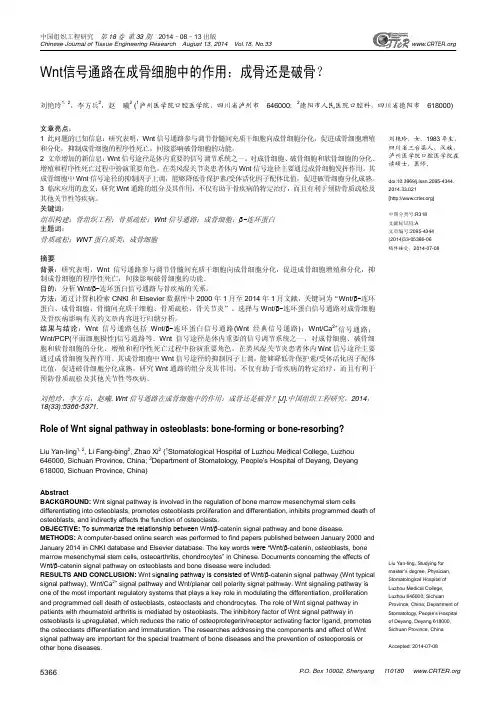
中国组织工程研究 第18卷 第33期 2014–08–13出版Chinese Journal of Tissue Engineering Research August 13, 2014 Vol.18, No.33P .O. Box 10002, Shenyang 110180 5366www.CRTER .org刘艳玲,女,1983年生,四川省三台县人,汉族,泸州医学院口腔医学院在读硕士,医师。
doi:10.3969/j.issn.2095-4344. 2014.33.021 []中图分类号:R318 文献标识码:A 文章编号:2095-4344 (2014)33-05366-06 稿件接受:2014-07-08Liu Yan-ling, Studying for master’s degree, Physician, Stomatological Hospital of Luzhou Medical College, Luzhou 646000, Sichuan Province, China; Department of Stomatology, People’s Hospital of Deyang, Deyang 618000, Sichuan Province, ChinaAccepted: 2014-07-08Wnt 信号通路在成骨细胞中的作用:成骨还是破骨?刘艳玲1,2,李方兵2,赵 曦2 (1泸州医学院口腔医学院,四川省泸州市 646000;2德阳市人民医院口腔科,四川省德阳市 618000)文章亮点:1 此问题的已知信息:研究表明,Wnt 信号通路参与调节骨髓间充质干细胞向成骨细胞分化,促进成骨细胞增殖和分化,抑制成骨细胞的程序性死亡,间接影响破骨细胞的功能。
2 文章增加的新信息:Wnt 信号途径是体内重要的信号调节系统之一,对成骨细胞、破骨细胞和软骨细胞的分化、增殖和程序性死亡过程中扮演重要角色。
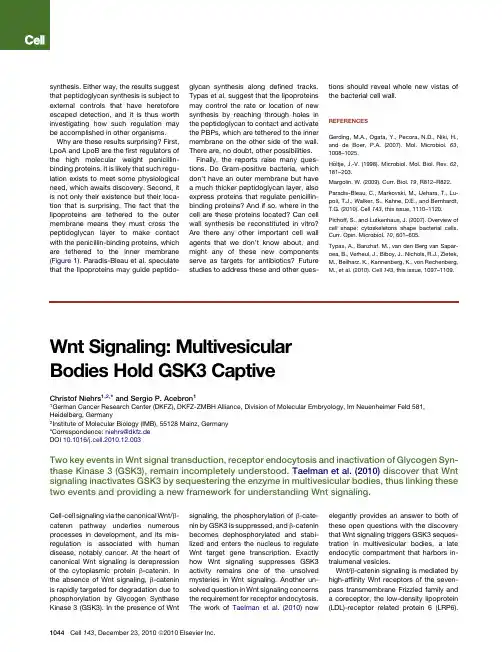
synthesis.Either way,the results suggest that peptidoglycan synthesis is subject to external controls that have heretofore escaped detection,and it is thus worth investigating how such regulation may be accomplished in other organisms. Why are these results surprising?First, LpoA and LpoB are thefirst regulators of the high molecular weight penicillin-binding proteins.It is likely that such regu-lation exists to meet some physiological need,which awaits discovery.Second,it is not only their existence but their loca-tion that is surprising.The fact that the lipoproteins are tethered to the outer membrane means they must cross the peptidoglycan layer to make contact with the penicillin-binding proteins,which are tethered to the inner membrane (Figure1).Paradis-Bleau et al.speculate that the lipoproteins may guide peptido-glycan synthesis along defined tracks.Typas et al.suggest that the lipoproteinsmay control the rate or location of newsynthesis by reaching through holes inthe peptidoglycan to contact and activatethe PBPs,which are tethered to the innermembrane on the other side of the wall.There are,no doubt,other possibilities.Finally,the reports raise many ques-tions.Do Gram-positive bacteria,whichdon’t have an outer membrane but havea much thicker peptidoglycan layer,alsoexpress proteins that regulate penicillin-binding proteins?And if so,where in thecell are these proteins located?Can cellwall synthesis be reconstituted in vitro?Are there any other important cell wallagents that we don’t know about,andmight any of these new componentsserve as targets for antibiotics?Futurestudies to address these and other ques-tions should reveal whole new vistas ofthe bacterial cell wall.REFERENCESGerding,M.A.,Ogata,Y.,Pecora,N.D.,Niki,H.,and de Boer,P.A.(2007).Mol.Microbiol.63,1008–1025.Ho¨ltje,J.-V.(1998).Microbiol.Mol.Biol.Rev.62,181–203.Margolin,W.(2009).Curr.Biol.19,R812–R822.Paradis-Bleau,C.,Markovski,M.,Uehara,T.,Lu-poli,T.J.,Walker,S.,Kahne,D.E.,and Bernhardt,T.G.(2010).Cell143,this issue,1110–1120.Pichoff,S.,and Lutkenhaus,J.(2007).Overview ofcell shape:cytoskeletons shape bacterial cells.Curr.Opin.Microbiol.10,601–605.Typas,A.,Banzhaf,M.,van den Berg van Sapar-oea,B.,Verheul,J.,Biboy,J.,Nichols,R.J.,Zietek,M.,Beilharz,K.,Kannenberg,K.,von Rechenberg,M.,et al.(2010).Cell143,this issue,1097–1109.Wnt Signaling:MultivesicularBodies Hold GSK3CaptiveChristof Niehrs1,2,*and Sergio P.Acebron11German Cancer Research Center(DKFZ),DKFZ-ZMBH Alliance,Division of Molecular Embryology,Im Neuenheimer Feld581, Heidelberg,Germany2Institute of Molecular Biology(IMB),55128Mainz,Germany*Correspondence:niehrs@dkfz.deDOI10.1016/j.cell.2010.12.003Two key events in Wnt signal transduction,receptor endocytosis and inactivation of Glycogen Syn-thase Kinase3(GSK3),remain incompletely understood.Taelman et al.(2010)discover that Wnt signaling inactivates GSK3by sequestering the enzyme in multivesicular bodies,thus linking these two events and providing a new framework for understanding Wnt signaling.Cell-cell signaling via the canonical Wnt/b-catenin pathway underlies numerous processes in development,and its mis-regulation is associated with human disease,notably cancer.At the heart of canonical Wnt signaling is derepression of the cytoplasmic protein b-catenin.In the absence of Wnt signaling,b-catenin is rapidly targeted for degradation due to phosphorylation by Glycogen Synthase Kinase3(GSK3).In the presence of Wnt signaling,the phosphorylation of b-cate-nin by GSK3is suppressed,and b-cateninbecomes dephosphorylated and stabi-lized and enters the nucleus to regulateWnt target gene transcription.Exactlyhow Wnt signaling suppresses GSK3activity remains one of the unsolvedmysteries in Wnt signaling.Another un-solved question in Wnt signaling concernsthe requirement for receptor endocytosis.The work of Taelman et al.(2010)nowelegantly provides an answer to both ofthese open questions with the discoverythat Wnt signaling triggers GSK3seques-tration in multivesicular bodies,a lateendocytic compartment that harbors in-tralumenal vesicles.Wnt/b-catenin signaling is mediated byhigh-affinity Wnt receptors of the seven-pass transmembrane Frizzled family anda coreceptor,the low-density lipoprotein(LDL)-receptor related protein6(LRP6).1044Cell143,December23,2010ª2010Elsevier Inc.Upon ligand binding,Wnt,Frizzled,and LRP6form a ternary signaling complex that clusters on polymers of the scaffold protein Disheveled to form endocytic sig-nalosomes (Bilic et al.,2007)(Figure 1).Formation of signalosomes promotes phosphorylation of LRP6,which is required for signal transmission.LRP6phosphory-lation occurs at so-called PPSP motifs and can be either dependent or indepen-dent of Wnt signaling,involving a variety of kinases including GSK3.GSK3phos-phorylates the PPSP motif of LRP6upon Wnt binding (Zeng et al.,2005)and thus has not only a negative role in Wnt signaling (via b -catenin phosphorylation)but also a positive one.LRP6phosphorylation pro-motes recruitment of the b -catenin des-truction complex consisting of GSK3,Axin,and Adenomatous Polyposis Coli (APC),which negatively regulate b -catenin by promoting its proteolysis.Their recruit-ment to the receptor complex inactivates GSK3and derepresses b -catenin,allowing it to accumulate,enter the nucleus,and engage in transcriptional activation.How Wnt signaling inactivates GSK3is unclear.In lysates derived from cells that have been stimulated with Wnt,the reduc-tion in GSK3enzyme activity is only tran-sient,lasting about 1hr (Ding et al.,2000;Taelman et al.,2010).This transient suppression may be due to direct inhibi-tion of GSK3by phosphorylated LRP6(Piao et al.,2008)but does not explain the sustained GSK3inhibition.Now Tael-man et al.show that Wnt signaling triggers sequestration of GSK3in multivesicular bodies,‘‘imprisoning’’the kinase and protecting potential substrates.Seques-tration of GSK3may account for the sus-tained inhibition of the enzyme.GSK3was known to accumulate in en-docytic LRP6signalosomes,but the nature of these endocytic vesicles has been unclear.Taelman et al.reveal that signalosomes colocalize with the late en-dosomal markers Rab7and te endosomes can give rise to multivesicluar bodies (MVBs)when a portion of the en-dosome membrane buds into its own lumen.Importantly,the topology is such that the cytoplasmic side of the plasma membrane,where GSK3is bound,corre-sponds to the lumen of the MVBs,thereby separating GSK3from the cytosol with two lipid bilayers (Figure 1).By electron microscopy and biochemical analysis the authors demonstrate that upon Wnt stimulation GSK3is indeed sequestered in MVBs.Furthermore,the authors show that Wnt signaling requires the ESCRT (endosomal sorting complexes required for transport)complex,which is essential for MVB biogenesis,providing further support for the role of MVBs in Wnt signaling.The sequestration of GSK3in MVBs is thus one reason canonical Wnt signaling requires endocytosis of Wnt receptor complexes (Kikuchi and Yama-moto,2007),but it may not be the only one.For example,endocytosis is also required for noncanonical Wnt signaling (Yu et al.,2007),where GSK3does not play a negative role.Likewise,recent work shows that vesicle acidification,which is mediated by vacuolar ATPase and occurs during endosomal traffic,is required for canonical and noncanonical Wnt signaling (Cruciat et al.,2010).Thus,endocytosis may play other roles in Wnt signaling beyond MVB formation.What is the final fate of signalosome MVBs?Although MVBs typically fuse with lysosomes to degrade their content,Wnt signaling does not induce a signifi-cant reduction in GSK3levels,suggesting that the signalosomes are stable.Indeed,in certain cells MVBs can give rise to specialized,secretory granules such as Weibel-Palade bodies of endothelial cells,alpha granules of platelets,or mast cell granules.Notably,MVBs can give rise to exosomes,secreted vesicles thatareFigure 1.Multivesicular Bodies in Wnt/b -Catenin SignalingWnt ligands bind receptors,the LDL-receptor related protein 6(LRP6),and Frizzled.Receptor complexes cluster on platforms of oligomerized Dishevelled (Dvl).Internalization of the Wnt-receptor complex begins,engaging the Pro-renin receptor (PRR)adaptor protein and vacuolar ATPase (v-ATPase).v-ATPase promotes vesicle acidification,which is essential for endocytosis and vesicle traffic.Receptor clustering triggers LRP6phosphorylation by Casein kinase 1gamma (CK1g ),as well as recruitment of GSK3and the destruction complex,which includes Axin.Signalosomes are recruited to the ESCRT (endosomal sorting complex required for transport)complex and sorted to vesicles destined for intralumenal budding.MVB formation sequesters GSK3,Dishevelled,Axin,and b -catenin from the cytoplasm.As a result,hundreds of cytoplasmic proteins are protected from GSK3-targeted degradation.Among them is b -catenin,which accumulates and enters the nucleus.Cell 143,December 23,2010ª2010Elsevier Inc.1045produced by a wide range of mammalian cells and can shuttle from one cell to another.These vesicles are reminiscent of‘‘argosomes’’in Drosophila imaginal discs,vesicles that travel through adja-cent tissue and colocalize with the Wing-less protein,the Drosophila Wnt homolog (Greco et al.,2001).It is therefore an intriguing possibility that signalosome MVBs containing the entire Wnt transduc-tion machinery can be secreted and affect Wnt signaling in neighboring cells. Remarkably,the authors also demon-strate,using protein labeling and pulse-chase experiments,that the inhibition of GSK3by Wnt signaling not only regulates b-catenin activity but also affects the half-life of20%of all cellular proteins.This finding is consistent with a recent bioinfor-matic analysis,predicting that hundreds of GSK3substrates may be degraded via the b-TrCP(b-transducing repeat-containing protein)ubiquitin ligase pathway(Xu et al., 2009).Thus,beyond b-catenin regulation, a major role of GSK3and Wnt signaling is control of global protein half-life.The study raises many new questions. For example,whereas signalosome for-mation and b-catenin stabilization occur within minutes of Wnt treatment,Taelman et al.only monitored GSK3sequestration in MVBs after a few hours of Wnt treat-ment.The different timescales raise the possibility that the fast inhibition of GSK3during Wnt signaling may occurvia binding to phospho-LRP6,whereassustained inhibition occurs by sequestra-tion.On the other hand,classical work onthe kinetics of MVB formation has shownthat more than70%of an epidermalgrowth factor:ferritin complex reachesMVBs within15min after internalization.This ratefits rather well with the fastkinetics of GSK3inactivation(Ding et al.,2000)as well as live-cell imaging kineticsof signalosome formation(Bilic et al.,2007).Thus the impact of transient versussustained GSK3inhibition and the relativecontribution of phosho-LRP6and MVBtoward GSK3inhibition remain to beresolved.Another conundrum is the un-expectedfinding that b-catenin itselflocalizes in MVBs and is required forMVB formation,a function that is clearlyseparate from its transcriptional role.Ifcytoplasmic b-catenin localizes in signal-osome MVBs,how does it escape andtravel to the nucleus?The authorssuggest that it may be newly synthesizedb-catenin that travels to the nucleus.Alternatively,b-catenin released fromplasma membrane stores may translo-cate to the nucleus.Finally,the emergingrole of GSK3as a global regulator ofprotein half-life may herald a paradigmchange from the predominantly transcrip-tion-centric view of Wnt signaling.Exami-nation of the many putative GSK3substrates will provide a new perspectiveof downstream effects elicited by Wntsignaling and the function of GSK3inmultiple cellular processes and signalingpathways.REFERENCESBilic,J.,Huang,Y.L.,Davidson,G.,Zimmermann,T.,Cruciat,C.M.,Bienz,M.,and Niehrs,C.(2007).Science316,1619–1622.Cruciat,C.M.,Ohkawara,B.,Acebron,S.P.,Kar-aulanov,E.,Reinhard,C.,Ingelfinger,D.,Boutros,M.,and Niehrs,C.(2010).Science327,459–463.Ding,V.W.,Chen,R.H.,and McCormick,F.(2000).J.Biol.Chem.275,32475–32481.Greco,V.,Hannus,M.,and Eaton,S.(2001).Cell106,633–645.Kikuchi,A.,and Yamamoto,H.(2007).J.Biochem.141,443–451.Piao,S.,Lee,S.H.,Kim,H.,Yum,S.,Stamos,J.L.,Xu,Y.,Lee,S.J.,Lee,J.,Oh,S.,Han,J.K.,et al.(2008).PLoS ONE3,e4046.Taelman,V.F.,Dobrowolski,R.,Plouhinec,J.,Fuentealba,L.C.,Vorwald,P.P.,Gumper,I.,Saba-tini,D.D.,and De Robertis,E.M.(2010).Cell143,this issue,1136–1148.Xu,C.,Kim,N.G.,and Gumbiner,B.M.(2009).CellCycle8,4032–4039.Yu,A.,Rual,J.F.,Tamai,K.,Harada,Y.,Vidal,M.,He,X.,and Kirchhausen,T.(2007).Dev.Cell12,129–141.Zeng,X.,Tamai,K.,Doble,B.,Li,S.,Huang,H.,Habas,R.,Okamura,H.,Woodgett,J.,and He,X.(2005).Nature438,873–877.1046Cell143,December23,2010ª2010Elsevier Inc.。
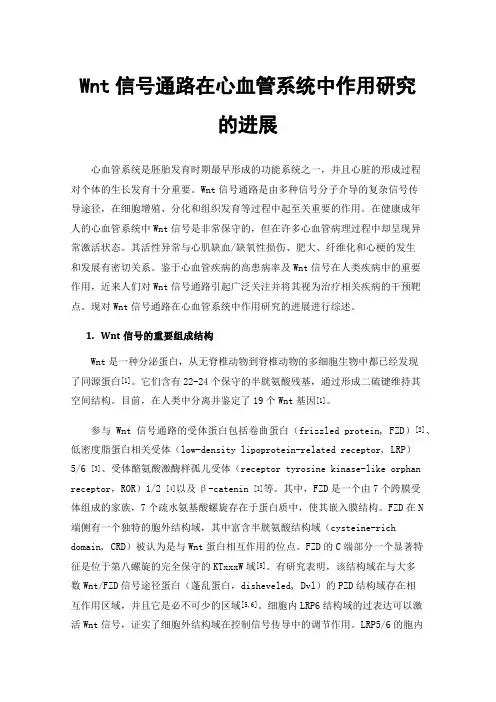
Wnt信号通路在心血管系统中作用研究的进展心血管系统是胚胎发育时期最早形成的功能系统之一,并且心脏的形成过程对个体的生长发育十分重要。
Wnt信号通路是由多种信号分子介导的复杂信号传导途径,在细胞增殖、分化和组织发育等过程中起至关重要的作用。
在健康成年人的心血管系统中Wnt信号是非常保守的,但在许多心血管病理过程中却呈现异常激活状态。
其活性异常与心肌缺血/缺氧性损伤、肥大、纤维化和心梗的发生和发展有密切关系。
鉴于心血管疾病的高患病率及Wnt信号在人类疾病中的重要作用,近来人们对Wnt信号通路引起广泛关注并将其视为治疗相关疾病的干预靶点。
现对Wnt信号通路在心血管系统中作用研究的进展进行综述。
1.Wnt信号的重要组成结构Wnt是一种分泌蛋白,从无脊椎动物到脊椎动物的多细胞生物中都已经发现了同源蛋白[1]。
它们含有22-24个保守的半胱氨酸残基,通过形成二硫键维持其空间结构。
目前,在人类中分离并鉴定了19个Wnt基因[1]。
参与Wnt信号通路的受体蛋白包括卷曲蛋白(frizzled protein, FZD)[2]、低密度脂蛋白相关受体(low-density lipoprotein-related receptor, LRP)5/6 [3]、受体酪氨酸激酶样孤儿受体(receptor tyrosine kinase-like orphan receptor,ROR)1/2 [4]以及β-catenin [1]等。
其中,FZD是一个由7个跨膜受体组成的家族,7个疏水氨基酸螺旋存在于蛋白质中,使其嵌入膜结构。
FZD在N端侧有一个独特的胞外结构域,其中富含半胱氨酸结构域(cysteine-rich domain, CRD)被认为是与Wnt蛋白相互作用的位点。
FZD的C端部分一个显著特征是位于第八螺旋的完全保守的KTxxxW域[5]。
有研究表明,该结构域在与大多数Wnt/FZD信号途径蛋白(蓬乱蛋白,disheveled, Dvl)的PZD结构域存在相互作用区域,并且它是必不可少的区域[5,6]。
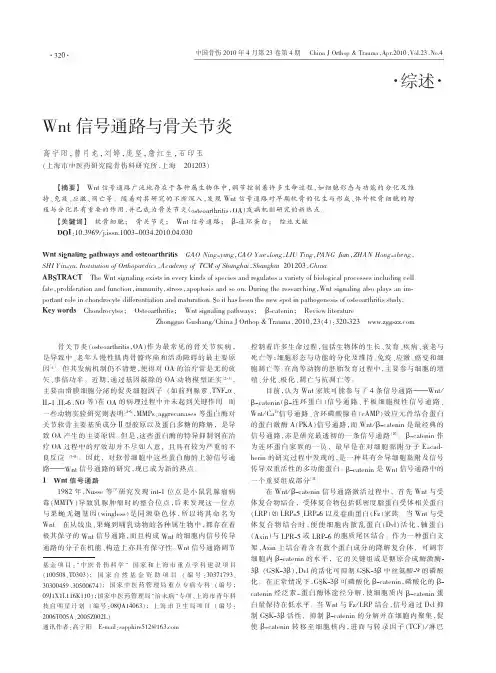
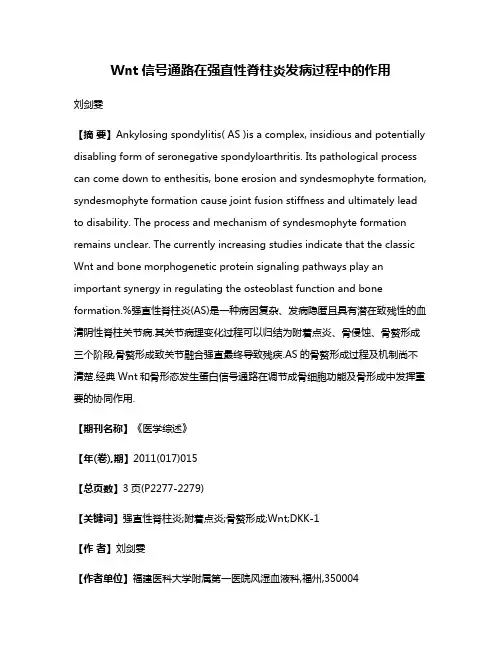
Wnt信号通路在强直性脊柱炎发病过程中的作用刘剑雯【摘要】Ankylosing spondylitis( AS )is a complex, insidious and potentially disabling form of seronegative spondyloarthritis. Its pathological process can come down to enthesitis, bone erosion and syndesmophyte formation, syndesmophyte formation cause joint fusion stiffness and ultimately lead to disability. The process and mechanism of syndesmophyte formation remains unclear. The currently increasing studies indicate that the classic Wnt and bone morphogenetic protein signaling pathways play an important synergy in regulating the osteoblast function and bone formation.%强直性脊柱炎(AS)是一种病因复杂、发病隐匿且具有潜在致残性的血清阴性脊柱关节病.其关节病理变化过程可以归结为附着点炎、骨侵蚀、骨赘形成三个阶段,骨赘形成致关节融合强直最终导致残疾.AS的骨赘形成过程及机制尚不清楚.经典Wnt和骨形态发生蛋白信号通路在调节成骨细胞功能及骨形成中发挥重要的协同作用.【期刊名称】《医学综述》【年(卷),期】2011(017)015【总页数】3页(P2277-2279)【关键词】强直性脊柱炎;附着点炎;骨赘形成;Wnt;DKK-1【作者】刘剑雯【作者单位】福建医科大学附属第一医院风湿血液科,福州,350004【正文语种】中文【中图分类】R59强直性脊柱炎(ankylosing spondylitis,AS)是以骶髂关节和脊柱慢性炎症为主的全身性疾病。
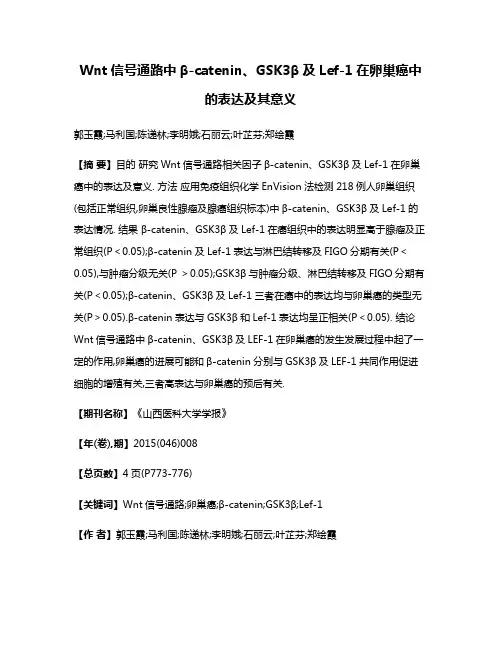
Wnt信号通路中β-catenin、GSK3β及Lef-1在卵巢癌中的表达及其意义郭玉霞;马利国;陈递林;李明娥;石丽云;叶芷芬;郑绘霞【摘要】目的研究Wnt信号通路相关因子β-catenin、GSK3β及Lef-1在卵巢癌中的表达及意义. 方法应用免疫组织化学EnVision法检测218例人卵巢组织(包括正常组织,卵巢良性腺瘤及腺癌组织标本)中β-catenin、GSK3β及Lef-1的表达情况. 结果β-catenin、GSK3β及Lef-1在癌组织中的表达明显高于腺瘤及正常组织(P<0.05);β-catenin及Lef-1表达与淋巴结转移及FIGO分期有关(P<0.05),与肿瘤分级无关(P >0.05);GSK3β与肿瘤分级、淋巴结转移及FIGO分期有关(P<0.05);β-catenin、GSK3β及Lef-1三者在癌中的表达均与卵巢癌的类型无关(P>0.05).β-catenin表达与GSK3β和Lef-1表达均呈正相关(P<0.05). 结论Wnt信号通路中β-catenin、GSK3β及LEF-1在卵巢癌的发生发展过程中起了一定的作用,卵巢癌的进展可能和β-catenin分别与GSK3β及LEF-1共同作用促进细胞的增殖有关,三者高表达与卵巢癌的预后有关.【期刊名称】《山西医科大学学报》【年(卷),期】2015(046)008【总页数】4页(P773-776)【关键词】Wnt信号通路;卵巢癌;β-catenin;GSK3β;Lef-1【作者】郭玉霞;马利国;陈递林;李明娥;石丽云;叶芷芬;郑绘霞【作者单位】暨南大学第二临床医学院,深圳市人民医院妇科,深圳518020;暨南大学第二临床医学院,深圳市人民医院妇科,深圳518020;暨南大学第二临床医学院,深圳市人民医院妇科,深圳518020;暨南大学第二临床医学院,深圳市人民医院妇科,深圳518020;暨南大学第二临床医学院,深圳市人民医院妇科,深圳518020;暨南大学第二临床医学院,深圳市人民医院妇科,深圳518020;山西医科大学第一医院病理科【正文语种】中文【中图分类】R737.31卵巢癌是妇科常见的恶性肿瘤,近几年来死亡率已位居女性生殖系统肿瘤的首位。
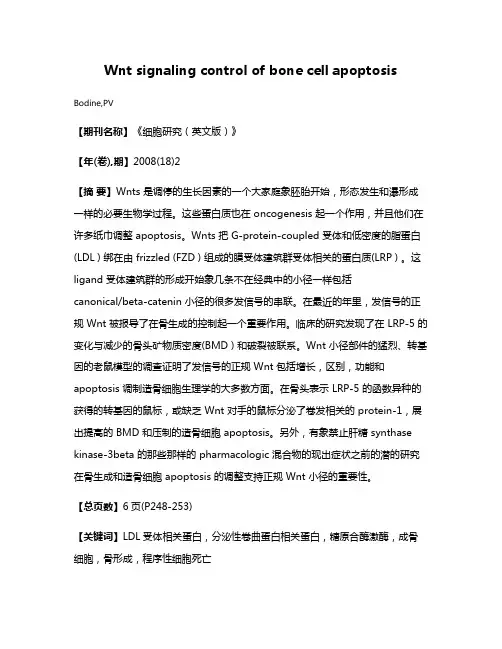
Wnt signaling control of bone cell apoptosis Bodine,PV【期刊名称】《细胞研究(英文版)》【年(卷),期】2008(18)2【摘要】Wnts 是调停的生长因素的一个大家庭象胚胎开始,形态发生和瀑形成一样的必要生物学过程。
这些蛋白质也在 oncogenesis 起一个作用,并且他们在许多纸巾调整 apoptosis。
Wnts 把 G-protein-coupled 受体和低密度的脂蛋白(LDL ) 绑在由 frizzled (FZD ) 组成的膜受体建筑群受体相关的蛋白质(LRP ) 。
这ligand 受体建筑群的形成开始象几条不在经典中的小径一样包括canonical/beta-catenin 小径的很多发信号的串联。
在最近的年里,发信号的正规 Wnt 被报导了在骨生成的控制起一个重要作用。
临床的研究发现了在 LRP-5 的变化与减少的骨头矿物质密度(BMD ) 和破裂被联系。
Wnt 小径部件的猛烈、转基因的老鼠模型的调查证明了发信号的正规 Wnt 包括增长,区别,功能和apoptosis 调制造骨细胞生理学的大多数方面。
在骨头表示 LRP-5 的函数异种的获得的转基因的鼠标,或缺乏 Wnt 对手的鼠标分泌了卷发相关的 protein-1,展出提高的 BMD 和压制的造骨细胞 apoptosis。
另外,有象禁止肝糖 synthase kinase-3beta 的那些那样的 pharmacologic 混合物的现出症状之前的潜的研究在骨生成和造骨细胞 apoptosis 的调整支持正规 Wnt 小径的重要性。
【总页数】6页(P248-253)【关键词】LDL受体相关蛋白,分泌性卷曲蛋白相关蛋白,糖原合酶激酶,成骨细胞,骨形成,程序性细胞死亡【作者】Bodine,PV【作者单位】Women's Health and Musculoskeletal Biology, Wyeth Research,Collegeville,Pennsylvania19426,*********************【正文语种】中文【中图分类】R329.2因版权原因,仅展示原文概要,查看原文内容请购买。
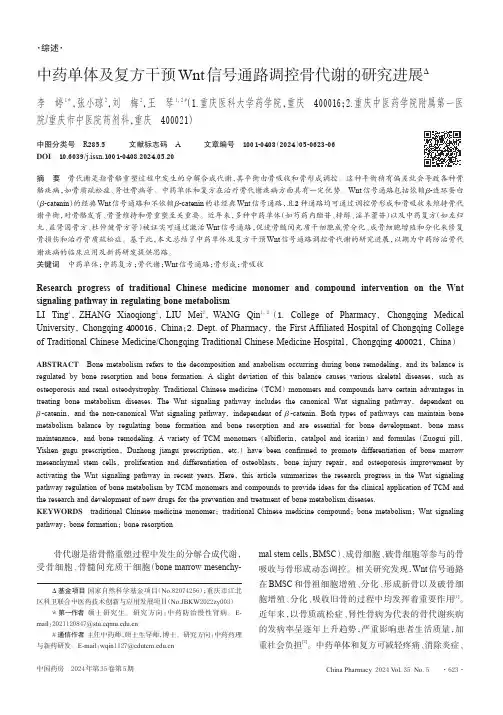
·综述·中药单体及复方干预Wnt信号通路调控骨代谢的研究进展Δ李婷1*,张小琼2,刘梅2,王琴1,2 #(1.重庆医科大学药学院,重庆 400016;2.重庆中医药学院附属第一医院/重庆市中医院药剂科,重庆 400021)中图分类号 R285.5文献标志码 A 文章编号 1001-0408(2024)05-0623-06DOI 10.6039/j.issn.1001-0408.2024.05.20摘要骨代谢是指骨骼重塑过程中发生的分解合成代谢,其平衡由骨吸收和骨形成调控。
这种平衡稍有偏差就会导致各种骨骼疾病,如骨质疏松症、肾性骨病等。
中药单体和复方在治疗骨代谢疾病方面具有一定优势。
Wnt信号通路包括依赖β-连环蛋白(β-catenin)的经典Wnt信号通路和不依赖β-catenin的非经典Wnt信号通路,且2种通路均可通过调控骨形成和骨吸收来维持骨代谢平衡,对骨骼发育、骨量维持和骨重塑至关重要。
近年来,多种中药单体(如芍药内酯苷、梓醇、淫羊藿苷)以及中药复方(如左归丸、益肾固骨方、杜仲健骨方等)被证实可通过激活Wnt信号通路,促进骨髓间充质干细胞成骨分化、成骨细胞增殖和分化来修复骨损伤和治疗骨质疏松症。
基于此,本文总结了中药单体及复方干预Wnt信号通路调控骨代谢的研究进展,以期为中药防治骨代谢疾病的临床应用及新药研发提供思路。
关键词中药单体;中药复方;骨代谢;Wnt信号通路;骨形成;骨吸收Research progress of traditional Chinese medicine monomer and compound intervention on the Wnt signaling pathway in regulating bone metabolismLI Ting1,ZHANG Xiaoqiong2,LIU Mei2,WANG Qin1,2(1. College of Pharmacy,Chongqing Medical University, Chongqing 400016, China;2. Dept. of Pharmacy, the First Affiliated Hospital of Chongqing College of Traditional Chinese Medicine/Chongqing Traditional Chinese Medicine Hospital, Chongqing 400021, China)ABSTRACT Bone metabolism refers to the decomposition and anabolism occurring during bone remodeling,and its balance is regulated by bone resorption and bone formation. A slight deviation of this balance causes various skeletal diseases,such as osteoporosis and renal osteodystrophy. Traditional Chinese medicine (TCM)monomers and compounds have certain advantages in treating bone metabolism diseases. The Wnt signaling pathway includes the canonical Wnt signaling pathway,dependent on β-catenin,and the non-canonical Wnt signaling pathway,independent of β-catenin. Both types of pathways can maintain bone metabolism balance by regulating bone formation and bone resorption and are essential for bone development,bone mass maintenance,and bone remodeling. A variety of TCM monomers (albiflorin,catalpol and icariin)and formulas (Zuogui pill,Yishen gugu prescription,Duzhong jiangu prescription,etc.)have been confirmed to promote differentiation of bone marrow mesenchymal stem cells,proliferation and differentiation of osteoblasts,bone injury repair,and osteoporosis improvement by activating the Wnt signaling pathway in recent years. Here,this article summarizes the research progress in the Wnt signaling pathway regulation of bone metabolism by TCM monomers and compounds to provide ideas for the clinical application of TCM and the research and development of new drugs for the prevention and treatment of bone metabolism diseases.KEYWORDS traditional Chinese medicine monomer;traditional Chinese medicine compound;bone metabolism;Wnt signaling pathway; bone formation; bone resorption骨代谢是指骨骼重塑过程中发生的分解合成代谢,受骨细胞、骨髓间充质干细胞(bone marrow mesenchy‐mal stem cells,BMSC)、成骨细胞、破骨细胞等参与的骨吸收与骨形成动态调控。
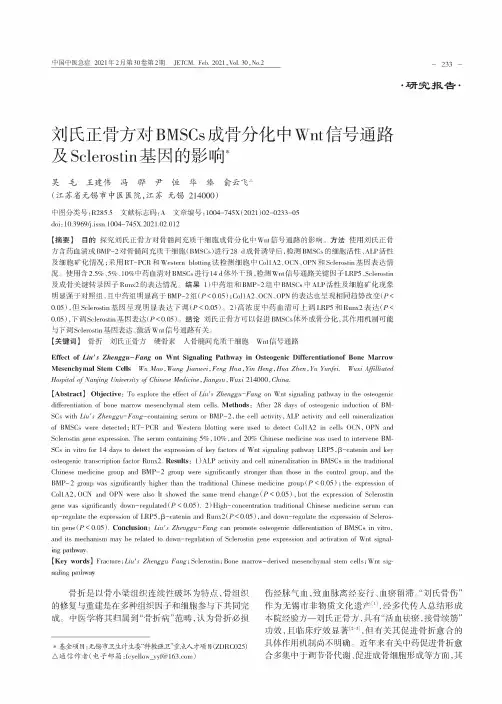
-研#报告-刘氏正骨方对BMSCs 成骨分化中W6信号通路 及Sclerostin 基因的影响**基金项目:无锡市卫生计生委“科教强卫'重J 人才项目(ZDRC025) △通信作者(电子邮箱:fcyellow_yyf@ )吴 毛 王建伟 冯骅尹 恒华臻 俞云飞<(江苏省无锡市中医医院,江苏无锡214000)中图分类号:R285.5文献标志码:A 文章编号:1004-745X (2021 )02-0233-05doi :10.3969/j.issn2000-705X.202402.012【摘要】目的探究刘氏正骨方对骨髓间充质干细胞成骨分化中Wnt 信号通路的影响。
方法使用刘氏正骨 方含药血清或BMP-2对骨髓间充质干细胞(BMSCs )进行28 d 成骨诱导后,检测BMSCs 的细胞活性、ALP 活性及细胞矿化情况;采用RT-PCR 和Western blotting 法检测细胞中CollA2、OCN 、OPN 和Sclerostin 基因表达情 况。
使用含2.5%、5%、10%中药血清对BMSCs 进行4 d 体外干预,检测Wnt 信号通路关键因子LRP5、Sclerostin及成骨关键转录因子Runx2的表达情况。
结果1)中药组和BMP-2组中BMSCs 中ALP 活性及细胞矿化现象 明显强于对照组,且中药组明显高于BMP-2组(P<0.05);CollA2、OCN 、OPN 的表达也呈现相同趋势改变(!<0.05),但Sclerostin 基因呈现明显表达下调(!<0.05)。
2)高浓度中药血清可上调LRP5和Runx2表达(P< 0.05),下调Sclerostin 基因表达(!<0.05)。
结论刘氏正骨方可以促进BMSCs 体外成骨分化,其作用机制可能与下调Sclerostin 基因表达、激活Wnt 信号通路有关。
【关键词】骨折刘氏正骨方硬骨素人骨髓间充质干细胞Wnt 信号通路Effect of Li" s Zhenggu-Fang on Wnt Signaling Pathway in Osteogenic Differentiationof Bone MarrowMesenchymal Stem Celis Wu Mao , Wang Jianwei , Feng Hua , Yin Heng , Hua Zhen , Yu Yunfei. Wuxi AffilliatedHospital of <aging Unnersite , Chinese Medicifn , Jiangsu , Wuxi 214000 , China.[Abstrocti Objective : T o explore the effect of Lils Zhenggu-Faag on Wnt signaling pathway in the osteogenicdifferentiation of bone marrow mesenchymal stem cells. Methode : After 28 days of osteogenic innuction of BM SCs with Liu s Zhenggu-Fang —dimng serum oo BMP-2 , the cell activity , ALP activity and cell mineralizationof BMSCs wero detected; RT-PCR and Western blottinn wero used te detect CollA2 in cells OCN , OPN and Sclerostin gene expression The serum containing 5% , 1 0% , and 20% Chinese meeicine was usee te intervene BM SCs in vitro for 14 days te detect the expressios of key factors of Wnt sivnaling pathway LRP5 , \-catenin and keyosteogenit Oanscnption factor Runx2. Results : 1) ALP activity and cell mineralization in BMSCs in the tranitionaiChinese menicine group and BMP- 2 group were sivnificantly 300^x 1' than those in the controi group , and the BMP-2was 30x )0(110, higher than the tranitionai Chinese mebicinc gump (!< 0.05) ; the expressios ofCollA2 , OCN and OPN were also ] showen the same trend change (!< 0.05) , but the expressios of Sclerostin gene was significantly down-reeulaten (! < 0.05). 2)High-concentration tranitionai Chinese menicine serum canup-regulate the expressios of LRP5 , \-catenin ang Runx2(!<0.05) , and down--egulate the expressios of Scleros tin gene (!< 0.05). Conclusion : Lus Zhenggu- Fang can promote osteooenic differentiatios of BMSCs in vitro , and its mechanism may be relateX h down-egulatios of Sclerostin gene expressios ang achvatios of Wnt signal-nngrnewns0【Key words 】 Fracture ;Liu s Zhenggu Fang; Sclerostin; Bose marrow-deriveX mesenchymal stem cells; Wnt sig-nnenngrnewns骨折是以骨小梁组织连续性破坏为特点,骨组织 的修复与重建是在多种组织因子和细胞参与下共同完成。
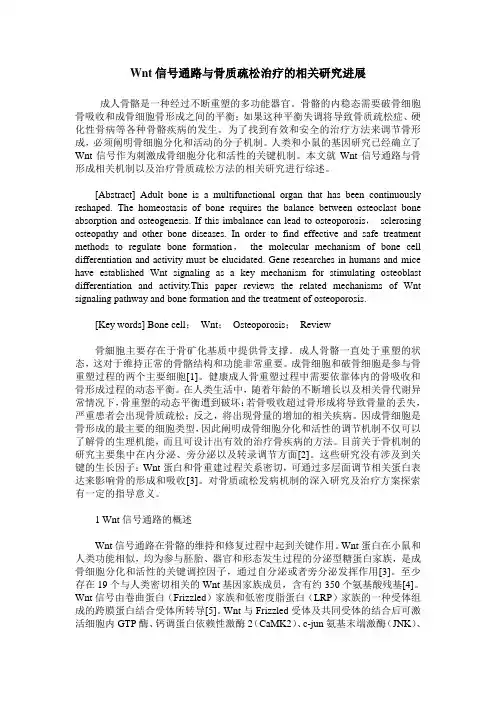
Wnt信号通路与骨质疏松治疗的相关研究进展成人骨骼是一种经过不断重塑的多功能器官。
骨骼的内稳态需要破骨细胞骨吸收和成骨细胞骨形成之间的平衡;如果这种平衡失调将导致骨质疏松症、硬化性骨病等各种骨骼疾病的发生。
为了找到有效和安全的治疗方法来调节骨形成,必须阐明骨细胞分化和活动的分子机制。
人类和小鼠的基因研究已经确立了Wnt信号作为刺激成骨细胞分化和活性的关键机制。
本文就Wnt信号通路与骨形成相关机制以及治疗骨质疏松方法的相关研究进行综述。
[Abstract] Adult bone is a multifunctional organ that has been continuously reshaped. The homeostasis of bone requires the balance between osteoclast bone absorption and osteogenesis. If this imbalance can lead to osteoporosis,sclerosing osteopathy and other bone diseases. In order to find effective and safe treatment methods to regulate bone formation,the molecular mechanism of bone cell differentiation and activity must be elucidated. Gene researches in humans and mice have established Wnt signaling as a key mechanism for stimulating osteoblast differentiation and activity.This paper reviews the related mechanisms of Wnt signaling pathway and bone formation and the treatment of osteoporosis.[Key words] Bone cell;Wnt;Osteoporosis;Review骨細胞主要存在于骨矿化基质中提供骨支撑。
wnt信号通路的生物学活性wnt信号通路(The Wnt signaling pathways)是复杂的生物信号转导结构网的一条。
其主要分为经典wnt信号途径和非经典wnt信号途径。
Wnt信号通路参与众多重要的生理病理过程,Wnt 通路调节造血干细胞及造血微环境,Wnt 通路参与控制神经前体细胞的增殖分化,在正常干/祖细胞池的保持方面有重要作用,且Wnt 信号通路与肿瘤的发生息息相关。
通过对wnt通路的研究,了解其对机体的影响,进一步针对其特征设计靶向药物是未来的研究重点。
关键词:wnt通路干细胞肿瘤生物活性WNT 名称来自于Wingless 和Int-1。
当缺失Wingless基因时,果蝇将无法长出翅膀,故命名为Wingless。
而Int-1 最早是作为老鼠乳腺癌的抑癌基因,当老鼠乳腺癌病毒占据Int-1 的结合位点时就会导致癌症的发生。
随着研究的不断深入,发现Wingless 和Int-1其实编码着同一种蛋白,故统一命名为WNT Wnt 信号途径是一类在生物体进化过程中高度保守的信号转导途径,调节控制着众多生命活动过程。
动物体早期发育中,Wnt 信号决定背腹轴的形成、胚层建立、体节分化、组织或器官形成等一系列重要事件;并直接控制着增殖、分化、极化、凋亡与抗凋亡等细胞的命运。
同时,Wnt 信号途径也与肿瘤发生密切相关。
在目前已知的癌症中,有十几种高发性癌变源于 Wnt 信号转导途径的失调。
根据 Wnt 蛋白转导信号的方式,人们又将 Wnt 信号转导途径分为经典 Wnt 信号途径(Canonical Wnt signal pathway)和非经典的 Wnt 信号途径(Noncanonical Wnt signal pathway)5-7。
2.1经典 Wnt 信号转导的分子机制经典 Wnt 信号途径也称为Wnt/β-catenin 信号途径。
在不同物种中 Wnt/β-catenin信号转导的分子机制具有极高的保守性。
Wnt信号通路调控间充质干细胞成骨分化的研究进展陈小静;高艳虹【摘要】Wnt通路作为调控细胞生长、发育和分化的重要信号途径一直是医学研究的热点.近年来的研究表明,Wnt信号通路在调控间充质干细胞(MSCs)成骨分化过程中发挥重要作用,其机制已成为骨组织工程研究的热点,也为骨质疏松症等疾病的治疗提供了新思路.该文对Wnt信号通路调控MSCs成骨分化的研究进展进行综述.%Wnt signaling pathway has been the focus of medical research as it plays a significant role in regulating the growth, development and differentiation of cells. Recent studies have revealed that Wnt signaling pathway may play an important role in regulating the osteogenic differentiation of mesenchymal stem cells ( MSCs) , the mechanism of which has been the hotspot of bone tissue engineering and provides a new way for the treatment of diseases such as osteoporosis. The research progress of Wnt signaling pathway in regulating osteogenic differentiation of MSCs is reviewed in this paper.【期刊名称】《上海交通大学学报(医学版)》【年(卷),期】2013(033)001【总页数】5页(P99-103)【关键词】间充质干细胞;Wnt信号通路;成骨分化;骨形成【作者】陈小静;高艳虹【作者单位】上海交通大学医学院附属新华医院老年医学科,上海200092;上海交通大学医学院附属新华医院老年医学科,上海200092【正文语种】中文【中图分类】Q23间充质干细胞(mesenchymal stem cells, MSCs)是近年来发现的一类具有多向分化潜能的成体干细胞,主要存在于骨髓,体外分离培养后在不同的诱导条件下MSCs具有向成骨细胞、成软骨细胞、脂肪细胞、成肌细胞和神经细胞等多种细胞系分化的能力[1]。
An Investigation of the Effects of the Core Protein Telomerase Reverse Transcriptase on Wnt Signaling in Breast Cancer CellsImke Listerman,Francesca S.Gazzaniga,Elizabeth H.BlackburnDepartment of Biochemistry and Biophysics,University of California at San Francisco,San Francisco,California,USATelomerase canonically maintains telomeres,but recent reports have suggested that the core protein mammalian telomerase reverse transcriptase(TERT)component,together with the chromatin remodeling factor BRG1and-catenin,may also bind to and promote expression of Wnt target genes.However,this proposed noncanonical role of TERT in Wnt signaling has been con-troversial.Here,we investigated the effects of human TERT(hTERT)on Wnt signaling in human breast cancer lines and HeLa cells.We failed tofind evidence for physical association of hTERT with BRG1or-catenin;instead,we present evidence that anti-FLAG antibody cross-reactivity properties may explain the previously reported interaction of hTERT with-catenin.Fur-thermore,altering hTERT levels in four different breast cancer cell lines caused minimal and discordant effects on Wnt target and Wnt pathway gene expression.Although hTERT’s role in Wnt signaling was addressed only indirectly,no significant repre-sentation of Wnt target genes was detected in chromatin immunoprecipitation-sequencing(ChIP-seq)and chromatin isolation by RNA purification and sequencing(ChIRP-seq)loci cooccupied in HeLa S3cells by both BRG1and hTR.In summary,our evi-dence fails to support the idea of a biologically consistent hTERT interaction with the Wnt pathway in human breast cancer cells, and any detectable influence of hTERT depended on cell type and experimental system.T he mammalian telomerase ribonucleoprotein complex adds TTAGGG repeats to telomeres,the ends of linear chromo-somes.The core human telomerase contains the catalytic reverse transcriptase protein component(hTERT)and the telomerase RNA(called hTR,hTER,or hTERC)that provides the template for telomeric DNA synthesis(1).In most human somatic cells, telomerase expression is very low.In contrast,telomerase expres-sion is upregulated in many human cancer cells and stem cells(2). In human cancer cells,the degree of telomerase expression seems higher than would appear necessary solely for maintaining telo-mere length.In fact,many studies suggest telomere-independent roles for telomerase.We and others have shown that overexpres-sion of TERT protects cells in culture from apoptosis indepen-dently of the telomere-lengthening properties of telomerase(3–5).Furthermore,overexpression of mouse and human TERT promotes cell proliferation in stem,normal,and cancer cell lines (6–11).Experiments employing overexpression or reduced ex-pression of hTERT in cells in culture have suggested roles for hTERT in controlling expression of growth factor response and other genes(9,12).Gene expression changes have been reported to occur as soon as1week after ectopic hTERT overexpression(9). Taken together,these results strongly suggest nontelomeric roles for telomerase;however,the mechanisms by which telomerase might protect against apoptosis and promote proliferation remain largely unknown.Some previous studies have linked TERT expression and Wnt/-catenin signaling,here referred to as Wnt signaling(13–15). The Wnt signaling pathway plays a central role in development, stem cell renewal,and cancer.In the absence of Wnt signaling, cytoplasmic-catenin is bound by destruction complex proteins, including AXIN,adenomatous polyposis coli(APC),and glyco-gen synthase kinase3beta(GSK3B).Consequently,-catenin is phosphorylated and degraded by the ubiquitin-proteasome path-way.When secreted Wnt proteins bind to Frizzled and low-den-sity lipoprotein receptor-related proteins(LRPs)at the plasma membrane,a signal is transduced to destabilize the-catenin de-struction complex.-Catenin can then translocate to the nucleus, where it complexes with T-cell factor/lymphoid enhancer factor (TCF/LEF)transcription factors to promote target gene transcrip-tion(16).The Wnt pathway has been previously shown to upregu-late telomerase in mouse mammary tumors and human cells(17, 18).Furthermore,-catenin may contribute to telomerase up-regulation in stem and cancer cells by directly regulating TERT expression via binding to the TERT promoter in complex with Klf4,as previously reported in a study of mouse adult stem cells and human carcinoma lines NTera2and SW480(15).Reciprocally,Park et al.previously suggested that TERT ex-pression promotes Wnt signaling(13).In that study,TERTϪ/Ϫknockout mice in thefirst generation were reported to have devel-opmental defects such as homeotic transformations of the vertebrae.Such defects,occurring before the onset of significant telomere shortening,resembled effects of aberrant Wnt signaling. Those authors additionally reported protein-protein interactions between hTERT and the chromatin remodeling factor BRG1and between hTERT and-catenin.It was also reported that TERT overexpression upregulated expression of a Wnt luciferase re-porter in TERTϪ/Ϫand TRϪ/Ϫmouse embryonicfibroblasts (MEFs)and humanfibroblast(BJ)cells and that,in SW-13and HeLa cancer cells,TERT overexpression hyperactivated a Wnt signaling reporter in a BRG1-dependent manner(13).Consistent with these results,Hrdlickováet al.reported increased prolifera-tion and a slight but significant increase in Wnt reporter activation Received28June2013Returned for modification6August2013Accepted4November2013Published ahead of print11November2013Address correspondence to Elizabeth H.Blackburn,Elizabeth.Blackburn@.I.L.and F.S.G.contributed equally to this article.Copyright©2014,American Society for Microbiology.All Rights Reserved.doi:10.1128/MCB.00844-13 Molecular and Cellular Biology p.280–289January2014Volume34Number2upon overexpression of either hTERT or a catalytically incompe-tent hTERT splice variant,in both U2OS(telomerase-deficient) and HeLa(telomerase-positive)cell lines(19).BRG1has been reported to bind to-catenin and to promote-catenin target gene expression(20,21).Because many growth-promoting genes are-catenin targets and because Wnt signaling plays an impor-tant role in self-renewal,proliferation,and survival,these reports suggested that TERT,in concert with BRG1,might promote cell proliferation via Wnt signaling.An influence of TERT on Wnt signaling has not been consis-tently reproduced in other experimental settings.Strong et al.did not detect homeotic transformations or diminished Wnt re-porter activity in TERTϪ/Ϫknockout mice or mouse embry-onicfibroblasts(MEFs)derived from these mice(22).The dis-crepancies between the two mouse TERTϪ/Ϫknockout studies could have been due to slightly different experimental condi-tions,such as different mouse backgrounds and/or Wnt signal-ing activators(13,22).Alternatively,the TERT overexpression system that identified a Wnt pathway interaction(13)may not produce a biologically relevant phenotype.While Strong et al. disputed a TERT/Wnt signaling interaction in mice and MEFs (22),they did not address a possible TERT/Wnt signaling in-teraction in human cancer cells.The primary aim of the present study was to determine whether hTERT promotes or otherwise affects Wnt signaling in cultured human breast cancer cells.Wnt signaling is often dys-regulated in breast cancer(23).Furthermore,either TERT over-expression or Wnt activation leads to mammary tumorigenesis in mice(23,24).We therefore focused on breast cancer cell lines to further study the potential for biologically relevant TERT/Wnt signaling interactions.MATERIALS AND METHODSCell lines.HeLa cells were purchased from the American Type Culture Collection(ATCC)and grown in Dulbecco’s modified Eagle’s medium (DMEM)with10%fetal bovine serum(FBS),1%penicillin-streptomy-cin,and1%GlutaMax(Invitrogen).HCC3153,HCC1806,SUM149PT, and MCF10A cells were obtained from the laboratory of Joe W.Gray, Oregon Health and Sciences University.HCC3153and HCC1806cells were grown in RPMI medium with10%FBS,1%penicillin-streptomycin, and1%GlutaMax(Invitrogen).SUM149PT cells were grown in Ham’s F-12medium with5%FBS,0.01mg/ml insulin,500ng/ml hydrocorti-sone,and1%penicillin-streptomycin.MCF10A cells were grown in DMEM–F-12with5%horse serum,20ng/ml epidermal growth factor, 100ng/ml cholera toxin,0.01mg/ml insulin,500ng/ml hydrocortisone, and1%penicillin-streptomycin.All cell lines were grown at37°C with5% CO2.Light microscopy.The HCC3153,HCC1806,SUM149PT,and MCF10A cell lines were grown on chamber slides(Lab-Tek II154526)and treated with25mM LiCl or200ng/ml Wnt3a(5036-WN-010/CF;R&D Systems)for4h.Cells werefixed in2%paraformaldehyde–phosphate-buffered saline(PBS)and permeabilized with0.5%NP-40–PBS.Immu-nostaining was performed with anti--catenin antibody clone14(BD Biosciences)followed by secondary Alexa Fluor488(Molecular Probes). DNA was visualized with4=,6-diamidino-2-phenylindole(DAPI;Invitro-gen).Images were acquired in0.5-m increments using a Deltavision RT deconvolution microscope(Applied Precision)with a100ϫ/1.40N PlanApo objective(Olympus).Images were deconvolved,Z-projected in Softworx(Applied Precision),and then adjusted for brightness and con-trast in FIJI(25).cDNA generation and qPCR.Total RNA was extracted with a Qiagen RNeasy minikit from cells treated with25mM LiCl,200ng/ml Wnt3a,or PBS for4h.cDNA synthesis was performed using2g RNA,random hexamers,and SuperScript III(Invitrogen).cDNA was amplified in10-l reaction mixtures containing LightCycler480DNA SYBR green I Master (Roche Applied Science)and a0.5to1mol/literfinal concentration of each primer using a Light Cycler480instrument(Roche Applied Science). The cycling conditions were95°C for5min,50cycles of95°C for10s and 60°C for20s,and72°C for20s.A melting curve(65to98°C)was gener-ated at the end of each run.Relative expression levels were determined by the2Ϫ⌬⌬CT method(26)and were normalized to GAPDH(glyceralde-hyde-3-phosphate dehydrogenase).AXIN2forward(5=-CATGTTCGTC ATGGGTGTGAACCA-3=)and AXIN2reverse(5=-TGGCTGGTGCAAA GACATAG-3=)and GAPDH forward(5=-CATGTTCGTCATGGGTGTG AACCA-3=)and GAPDH reverse(5=-ATGGCATGGACTGTGGTCATG AGT-3=)primers were used.For Wnt target gene expression analysis,cell lines were transduced with control or wild-type hTERT lentivirus pHR=cytomegalovirus(CMV)-hTERT-internal ribosome entry site (IRES)-PURO and selected with1g(HCC1806and SUM149PT)or2g (HCC3153)puromycin for3days and allowed to recover for1to2days. Cells were treated with25mM LiCl for6h,following total RNA extraction using an RNeasy kit(Qiagen)and cDNA generation using an RT2First Strand kit(Qiagen)according to the manufacturer’s instructions.A total of84Wnt target genes were measured using quantitative PCR(qPCR) human Wnt signaling target arrays(PAHS-243G;SABiosciences)accord-ing to the manufacturer’s instructions.A minimum cutoff of a2.5-fold change compared to control results was used to determine significant gene changes.Wnt luciferase reporter assays.The M50Super TOPFLash and M51 Super FOPFlash luciferase reporter vectors were obtained from Addgene (27).pRL-TK Renilla luciferase was used as an internal control(Invitro-gen).The lentivirus plasmids pBARL(-catenin activated reporter lucif-erase)and pfuBARL(mutated pBARL)and pSL9/rLuc(Renilla luciferase) were obtained from the laboratory of Randall Moon,University of Wash-ington(28).Cells were seeded on96-well microplates(655083;Greiner Bio-One),and each well was transiently transfected with0.5pg pRL-TK control along with either50pg SUPER TOPFLash or50pg mutated FOPFLash and with either10pg empty vector or10pg pcDNA3-FLAG-hTERT using X-tremeGene HP(Roche)and treated or not treated with25 mM LiCL for24h,followed by cell lysis with passive lysis buffer(Pro-mega)for10min and analysis using a dual-luciferase reporter assay sys-tem(Promega).Firefly and Renilla luciferases were read with a Veritas Microplate Luminometer(Turner Biosystems).Lentivirus production and transduction were carried out as previously described(28).Stable cell lines expressing reporter Renilla luciferase,pBARL,or pfuBARL lentivirus were generated as reported previously(28),using the same titer of lenti-virus in all cell lines.Then,cell lines were transduced with either control or hTERT lentivirus(28),selected with puromycin,treated with25mM LiCl for24h,and analyzed as described above.Background luciferase readings were subtracted,andfirefly luciferase values were normalized to Renilla luciferase.RNA interference(RNAi).Lentivirus expressing short hairpin RNAs (shRNAs)against-catenin(5=-CCGGAGGTGCTATCTGTCTGCTCT ACTCGAGTAGAGCAGACAGATAGCACCTTTTTT-3=;29),hTERT (5=-GGAGACCACGTTTCAAAAGTCTCTTGAACTTTTGAAACGTGG TCTCC-3=),and scramble shRNA(5=-GTTCTACAACGTAACGAGGTT TCTCTTGAAAACCTCGTTACGTTGTAGAAC-3=;30)was generated as described previously(30).Cells were transduced with shRNA and control vector lentivirus and were selected with1g/ml puromycin for3days and then expanded.IP and Western blotting.HeLa cells were transfected with pcDNA3 constructs containing wild-type hTERT with one N-terminal FLAG tag using Lipofectamine2000(Invitrogen)for18h,followed by treatment with25mM LiCl for6h.The following antibodies were used:anti-FLAG (M2;Sigma F3165and F1804),anti-BRG1(H-88;Santa Cruz),anti--catenin(clone14)(610153;Transduction Laboratories),and anti-GAPDH(MAB374;EMD Millipore).Cell lysis and immunoprecipitationhTERT Effects on Wnt Signaling in Breast Cancer281(IP)procedures and immunoblotting were done as described previously (13),using Western Lightning Plus ECL(PerkinElmer)for detection of horseradish peroxidase-conjugated secondary antibodies and Gamma-Bind G Sepharose(GE Healthcare Life Sciences)for preclearing and IP.Bioinformatics analysis.We determined the union of published BRG1-and hTR-enriched regions identified by chromatin immunopre-cipitation-sequencing(ChIP-seq)and chromatin isolation by RNA puri-fication and sequencing(ChIRP-seq),respectively,in HeLa S3cells(31, 32)and merged any united regions that were separated byՅ100bp using the ChIPPeakAnno R package(33).Enriched gene sets were obtained through use of the Genomic Regions Enrichment of Annotations Tool (GREAT)(34)on all145genomic regions.Gene ontology(GO)terms were identified using DAVID(35,36).RESULTSEndogenous Wnt signaling competency varies among the basal breast cancer cell lines SUM149PT,HCC1806,HCC3153,and MCF10A.One immortalized breast cell line with low telomerase activity and three basal breast cancer cell lines with midrange to high levels of telomerase activity(MCF10A[lower telomerase ac-tivity level],HCC3153[midrange telomerase activity level],and SUM149PT and HCC1806[higher telomerase activity levels]) were selected(4).First,to determine the extent of Wnt signaling in the breast cancer cell lines,we induced Wnt signaling with Wnt3a or LiCl.Wnt3a activates the pathway at the cell surface receptor level and specifically induces-catenin signaling by binding to Frizzled and LRP receptors(37).LiCl pharmacologically inhibits GSK3B kinase activity in the cytoplasm,thus leaving-catenin un-phosphorylated and stabilized(38).Under control conditions,both SUM149PT and HCC3153cells showed diffuse cytoplasmic and nuclear-catenin staining,suggesting that they may have had dysregulated Wnt signaling,which is found frequently in breast cancers(39).Upon Wnt3a orLiCl treatment,SUM149PT and HCC3153cells showed strongernuclear localization of-catenin(Fig.1A).In accordance with theincreased nuclear localization of-catenin in those cells,bothtreatments increased the expression of the endogenous AXIN2-catenin target gene(Fig.1B).In contrast,in HCC1806cells,-catenin was largely membrane bound and remained so even after LiCl or Wnt3a treatment(Fig.1A).Consistent with thesefindings,HCC1806cells did not significantly upregulate AXIN2after Wnt signaling induction(Fig.1B).In MCF10A cells,-catenin was also largely membrane bound but showed weak nuclear localization after LiCl or Wnt3A treatment(Fig.1A),and AXIN2was moderately upregulated(Fig.1B).These results sug-gest that HCC1806cells are not competent for Wnt signaling in-duction by LiCl or Wnt3A.We conclude that Wnt signaling can be activated in SUM149PT and HCC3153lines,and somewhat less in MCF10A cells,but at most minimally in HCC1806cells.hTERT overexpression has minimal and nonconcordant ef-fects on Wnt signaling reporters in breast cancer cell lines.Hav-ing established that HCC3153,SUM149PT,and MCF10A but notHCC1806cancer cells can strongly to moderately activate Wntsignaling,we tested whether hTERT overexpression modulatedWnt signaling reporter genes in these lines,as has been reportedfor MEFs,HeLa cells,and U2OS cells(13,19).For independentFIG1Endogenous Wnt/-catenin target gene induction varies in breast cancer cell lines.(A)Cell lines SUM149PT(high telomerase),HCC3153(medium telomerase),HCC1806(high telomerase),and MCF10A(low telomerase)were treated with PBS,25mM LiCl,or200ng/ml Wnt3a for4h prior to staining for -catenin(green)and DAPI(blue).(B)The increase in Wnt/-catenin target gene AXIN2mRNA expression over that of PBS control-treated cells was measuredby qRT-PCR following activation with Wnt3a or LiCl for4h.Listerman et al. Molecular and Cellular Biologyverification,we employed two different Wnt signaling reporter construct systems with multimerized TCF/LEF binding sites driv-ing luciferase expression:the M50Super TOPFlash reporter and its corresponding control M51Super FOPFlash Wnt reporter(27) and the BARL(-catenin activated reporter luciferase)/fuBARL (control)system(28).While TOPFlash contains7TCF/LEF bind-ing sites and was transiently expressed via plasmid transfection, BARL contains12TCF/LEF binding sites and was stably inte-grated.Vector or hTERT plasmids were cotransfected together with TOPFlash/FOPFlash in SUM149PT,HCC5313,HCC1806, MCF10A,and HeLa cells,followed by LiCl treatment(Fig.2A).As expected,LiCl treatment strongly increased luciferase activity in the vector-transfected TOPFlash SUM149PT,HCC3153, MCF10A,and HeLa cells.LiCl treatment induced the luciferase activity in HCC1806cells only weakly,with maximum luciferase expression being5-to100-fold lower than in the other four cell lines,consistent with our observations(Fig.1),indicating that HCC1806cells are severely impaired in Wnt signaling.Further-more,only HCC3153cells exhibited a statistically significant but mild(ϳ1.4-fold)increase in relative luciferase activity over that of the vector control,while the relative luciferase activity did not change significantly compared to that of vector controls in SUM149PT,HCC1806,MCF10A,or HeLa cells.In the pBARL cells,overexpressing hTERT increased luciferase activity over that of the vector control cells only in HCC3153cells(byϳ2-fold) (Fig.2B).Overexpression of hTERT did not detectably change the luciferase activity in SUM149PT,HCC1806,or MCF10A cell lines expressing pBARL.In HeLa cells that stably expressed the TCF/ LEF mutant(control)binding site construct,fuBARL,with hTERT overexpression,we observed anϳ3-fold increase in lucif-erase activity over that of control cells.However,in HeLa cells stably expressing BARL,there was an onlyϳ2-fold increase in luciferase activity in hTERT-overexpressing cells over that of control cells(Fig.2B).Hence,hTERT overexpression activated luciferase expression regardless of the presence or absence of a functional TCF/LEF promoter in HeLa cells.Because hTERT overexpression led to mild hyperactivation of both Wnt signaling reporters only in HCC3153cells and not in the four other cell lines,we conclude that Wnt reporter hyperactivation through hTERT is dependent on the context.Hence,hTERT does not hy-peractivate Wnt reporters universally but instead does so in a cellline-and context-dependent manner.Lack of evidence for hTERT interaction with-catenin orBRG1in HeLa cells.Since Park et al.(13)reported that FLAG-hTERT in HeLa cells coimmunoprecipitated(co-IP)with BRG1,aprotein previously reported to interact with-catenin(13,20),wealso investigated hTERT/Wnt pathway interactions using HeLacells.To independently verify the previously published results(13),we transiently overexpressed FLAG-hTERT in LiCl-treatedHeLa cells and tested whether BRG1or-catenin interacted withFLAG-hTERT by coimmunoprecipitation(co-IP).Interestingly,using the same buffers as described by Park et al.(13)and thenon-affinity-isolated version of anti-FLAG antibody M2(F3165;Sigma)for IP,we observed a strong band migrating slightly slowerthan the-catenin band in Western blots(M2lanes in Fig.3A)when the FLAG-IP Western blot was stained with the-cateninantibody.Importantly,we also observed the same band in similarquantities independently of whether FLAG-hTERT was expressedin the HeLa cells(M2lanes in Fig.3A)and using a variety ofwashing procedures in the IP and Western blot experiments.Weextended these experiments using the affinity-isolated anti-FLAGM2antibody(F1804;Sigma),which,while it did not enrich forthis background band,instead detected another band of the ex-pected size for-catenin at low levels(1.7-fold over IgG control IPresults)that again were identical regardless of whether FLAG-hTERT was expressed(Fig.3B).We verified the identity of thiscross-reacting coimmunoprecipitated protein band as-cateninby RNAi:reducing-catenin expression produced correspondingreductions in the intensity of the band pulled down by the affinity-purified M2antibody co-IP experiments(Fig.3C).Thus,we didnot detect a significant or specific interaction between hTERT and -catenin in HeLa cells above the background signals caused by anti-FLAG antibody ing the same antibodiesand IP buffers as Park et al.(13),we were also unable to detect aninteraction between overexpressed FLAG-hTERT and endoge-nous BRG1,despite obtaining high signals corresponding toFLAG-hTERT itself with the FLAG antibodies used(Fig.3B).In addition,we were able to detect only a weak interaction,atbest,between endogenous levels of BRG1and-catenin;suchan interaction has previously been reported only in a BRG1FIG2Effect of hTERT overexpression on two Wnt/-catenin reporters.(A)SUM149PT,HCC3153,HCC1806,MCF10A,and HeLa cells were transiently transfected with pRL-TK Renilla luciferase vector(internal control),hTERT or vector,and M50SuperTOPFlash or M51SuperFOPFlash reporter vectors and treated or not treated with25mM LiCl for24h prior to luciferase measurement.*,PϽ0.05.(B)Cell lines were transduced with pSL9/rLuc,pBARL,or pfuBARL and either hTERT or vector control lentivirus and selected for stable expression prior to LiCl treatment and luciferase measurement.hTERT Effects on Wnt Signaling in Breast Cancer 283overexpression context(20).We conclude,first,that the en-dogenous expression levels of BRG1in HeLa cells were too low to detect strong interactions with-catenin in our experi-ments,second,that M2anti-FLAG antibody cross-reacts with a protein with a gel mobility close to that of-catenin,and third, that the interaction of FLAG-hTERT with BRG1or with -catenin was not significantly above background IP levels.BRG1and hTR do not colocalize at Wnt target genes.In hu-man cells,the hTERT protein and the telomerase RNA hTR,to-gether with additional proteins,assemble to form the telomerase ribonucleoprotein complex,although it has not been determined what fractions of the total levels of hTERT and hTR exist in these complexes.Previously,Chu et al.(31)used whole-genome chro-matin isolation by RNA purification(ChIRP)in HeLa S3cells to detect hTR associated with chromatin at2,198genomic locations in HeLa S3cells.Those authors additionally reported that the hTR-bound peaks they had identified were significantly enriched at loci of genes in the“Wnt receptor signaling pathway”gene ontology(GO)term and on this basis proposed that hTR in com-plex with hTERT cooccupies Wnt target genes(31).Given the evidence described above that a previously reported interaction between hTERT and-catenin protein can be explained by cross-reactivity of anti-FLAG antibody rather than a bonafide interac-tion,we used a bioinformatics approach to reexamine any poten-tial connection between the published genomic localizations of BRG1cross-linked sites,telomerase RNA cross-linked sites,and Wnt signaling genes.To identify loci on the HeLa S3genome enriched for localization sites of both BRG1and hTR(with hTR inferred to likely be in complex with hTERT,as was described previously[31]),we merged the published BRG1-enriched local-ization sites identified by ChIP-seq in HeLa S3cells(32)and the published hTR-enriched localization sites(31).We applied the criterion that they were separated byՅ100bp,as the same crite-rion was previously used to determine cooccupancy of BRG1with other members of the SWI/SNF complex at genomic loci(32). Using this criterion,217genes in the vicinity of the merged BRG1/ hTR-enriched loci were identified.However,while“Positive reg-ulation of apoptosis”was identified as a highly significant GO term among these217genes,Wnt signaling was not identified as a significant GO term(Table1).Of the217genes,only MYC is known to be a target gene of Wnt signaling.Thus,this analysis in HeLa S3cells(applying the criterion of peak separation no greater than100bp)failed to verify any significant cooccupancy by hTR and BRG1of Wnt target genes or their nearby controlling regionsFIG3hTERT does not interact with-catenin or BRG1.(A)Anti--catenin antibody cross-reacts with anti-FLAG immunoprecipitate.HeLa cells were either transfected with pcDNA3-FLAG-hTERT for16h(left)or left untransfected(right),followed by treatment with25mM LiCl or no LiCl treatment.Precipitates from anti--catenin(clone14)or anti-FLAG(M2antibody F3165,Sigma)IP were subjected to Western blotting(WB)with anti--catenin(clone14)or anti-FLAG antibodies.The asterisk indicates a slower-migrating background band.(B)Top:Western blot of HeLa cells transfected with FLAG-hTERT(right hand side)or left untransfected(left hand side)following IP with specific antibodies.M indicates size marker lane.Bottom:Western blot of input samples from experiment.(C)Top:Western blot of HeLa cells treated with or without-catenin shRNA following IP with specific antibodies.Bottom:Western blot of input samples from the experiment.Listerman et al. Molecular and Cellular Biologyexcept for MYC.This analysis does not directly address hTERT and BRG1cooccupancy on chromatin genomic loci.However, because some fractions of hTERT and hTR exist as telomerase complexes in HeLa S3cells,colocalization of hTR with BRG1at Wnt signaling gene loci might be predicted if hTERT protein and BRG1protein interact,as suggested previously(31).Our negative finding for hTR and BRG1cooccupancy at Wnt signaling gene loci thus does not support,but by itself does not refute,the possibility of interaction between hTERT and BRG1.Effects of hTERT overexpression on Wnt signaling target gene expression in cell lines do not reflect cellular Wnt signaling competency.While our bioinformatics data analysis did not iden-tify a significant overlap of Wnt pathway genes with genomic loci cross-linkable to hTR and BRG1in HeLa cells,this analysis did not exclude the possibility that TERT,possibly not bound to hTR,still promotes Wnt signaling.To test directly whether hTERT modu-lates endogenous Wnt signaling target gene expression in breast cancer cells,we stably overexpressed hTERT in the high-Wnt-signaling SUM149PT and HCC3153cells and,as a control,in the Wnt-signaling-impaired HCC1806cells.We then measured the mRNA levels of84endogenous Wnt downstream target genes supplied as arrays for quantitative RT-PCR(qRT-PCR)(see Ma-terials and Methods).First,with hTERT overexpression(Fig.4C), the Wnt-signaling-competent SUM149PT cells showed a modest overall trend to greater expression of the Wnt target genes as a group compared with vector controls;however,this trend was no greater than that seen for the Wnt-signaling-impaired HCC1806TABLE1Significant GO terms for genes close to BRG1and hTR co-occupied loci in HeLa S3genomeGene GO term P valueGO:0043065Positive regulation of apoptosis0.005GO:0006928Cell motion0.025GO:0051693Actinfilament capping0.027GO:0007028Cytoplasm organization0.035GO:0006917Induction of apoptosis0.035GO:0048146Positive regulation offibroblast proliferation0.037GO:0030834Regulation of actinfilament depolymerization0.040GO:0033043Regulation of organelle organization0.043GO:0032272Negative regulation of protein polymerization0.045GO:0032271Regulation of protein polymerization0.046FIG4Effect of hTERT overexpression on Wnt target gene expression in breast cancer cell lines.SABiosciences qPCR arrays were used to measure the effect of hTERT overexpression on the mRNA expression of endogenous Wnt target genes after treatment with25mM LiCl for6h.(A)Scatter plots of log-transformed relative expression levels of each gene.Red lines indicate a2.5-fold change in gene expression.(B)Wnt target genes that changedϮ2.5-fold compared to the control results(indicated by dotted line)upon hTERT overexpression in SUM149PT,HCC1806,and HCC3153cells.(C)hTERT mRNA expression relative to GAPDH mRNA and vector control expression in SUM149PT,HCC1806,and HCC3153.Bars represent means of the results of3(SUM149PT and HCC1806)and 2(HCC3153)biological replicates.Error bars indicate standard deviations(SD).hTERT Effects on Wnt Signaling in Breast Cancer 285。
Wnt 信号通路对牙齿发育和牙囊成骨向分化的调控作用陈婵婵(综述);凌均蓕(审校)【摘要】Wnt 信号通路包括经典 Wnt/β-catenin 信号通路和非经典通路,对个体组织发育和干细胞的自我更新具有重要调控作用,在包括颅面部器官在内的几乎所有器官发生过程中都必需 Wnt 信号通路的调控。
研究发现,Wnt/β-catenin 信号通路不仅在牙齿发育过程中参与了上皮和间充质的相互作用,在牙囊细胞的分化过程亦有 Wnt 信号通路的参与。
本文就 Wnt 信号通路在牙齿发育和牙囊成骨/成牙骨质向分化中的调控作用研究进展作一综述。
%Abstract] Wnt signalling pathways include the canonical Wnt pathway and non -canonical pathways.Grow-ing evidence indicates that Wnt signaling pathways orchestrate tissue development and stem cell self-renewal.Wnt/β-catenin signaling is known to be crucial for tooth development and bone formation.Furthermore,several members of the Wnt family were observed in the presumptive dental epithelium or mesenchyme.The differentiation of dental follicle cells needs the regulation of Wnt signaling.This review emphasizes the role of Wnt signalling pathways in tooth devel-opment and the osteogenic differentiation of dental follicle.【期刊名称】《牙体牙髓牙周病学杂志》【年(卷),期】2015(000)003【总页数】4页(P175-178)【关键词】Wnt 信号通路;牙齿发育;牙囊;成骨向分化【作者】陈婵婵(综述);凌均蓕(审校)【作者单位】中山大学光华口腔医学院·附属口腔医院·口腔医学研究所,广东广州510055;中山大学光华口腔医学院·附属口腔医院·口腔医学研究所,广东广州510055【正文语种】中文【中图分类】R780.2Wnt是一类分泌型糖蛋白,在哺乳动物中至少有19种,是Wnt信号通路中的关键蛋白,可通过自分泌或旁分泌发挥作用。
ReviewUpdate on Wnt signaling in bone cell biology and bone diseaseDavid G.Monroe a ,Meghan E.McGee-Lawrence b ,Merry Jo Oursler a ,c ,Jennifer J.Westendorf b ,c ,⁎a Department of Medicine/Endocrine Research Unit,Mayo Clinic,200First Street SW,Rochester,MN 55905,USAb Department of Orthopedic Surgery/Division of Orthopedic Research,Mayo Clinic,200First Street SW,Rochester,MN 55905,USA cDepartment of Biochemistry and Molecular Biology,Mayo Clinic,200First Street SW,Rochester,MN 55905,USAa b s t r a c ta r t i c l e i n f o Article history:Accepted 20October 2011Available online 3November 2011Received by Meghan Jendrysik Keywords:Lrp5Lrp6Sclerostin β-catenin R-spondinBone mineral density PolymorphismsFor more than a decade,Wnt signaling pathways have been the focus of intense research activity in bone biology laboratories because of their importance in skeletal development,bone mass maintenance,and therapeutic potential for regenerative medicine.It is evident that even subtle alterations in the intensity,amplitude,location,and duration of Wnt signaling pathways affects skeletal development,as well as bone remodeling,regeneration,and repair during a lifespan.Here we review recent advances and discrepancies in how Wnt/Lrp5signaling regulates osteoblasts and osteocytes,introduce new players in Wnt signaling pathways that have important roles in bone development,discuss emerging areas such as the role of Wnt signaling in osteoclastogenesis,and summarize progress made in translating basic studies to clinical therapeutics and diagnostics centered around inhibiting Wnt pathway antagonists,such as sclerostin,Dkk1and Sfrp1.Emphasis is placed on the plethora of genetic studies in mouse models and genome wide association studies that reveal the requirement for and crucial roles of Wnt pathway components during skeletal development and disease.©2011Elsevier B.V.All rights reserved.Contents 1.Introduction ...............................................................21.1.Wnt signaling pathways ......................................................21.1.1.Wnt –β-catenin signaling .................................................21.1.2.Non-β-catenin Wnt signaling pathways ..........................................31.2.Osteoblast and osteoclast lineages:differentiation,maturation and coupling .............................52.Wnts and Wntless ............................................................52.1.Wnts ...............................................................52.1.1.Wnt3a ..........................................................62.1.2.Wnt5a ..........................................................62.1.3.Wnt10b .........................................................62.1.4.Wnt14..........................................................62.2.Wntless (Wls,Evi,Gpr177)....................................................72.3.R-spondins ............................................................73.Wnt receptors ..............................................................73.1.LDL receptor-related proteins ...................................................73.1.1.Lrp5...........................................................73.1.2.Lrp6...........................................................83.1.3.Lrp4...........................................................8Gene 492(2012)1–18Abbreviations:AER,apical ectodermal ridge;Apc,adenomatous polyposis coli;Bmp,bone morphogenic protein;Ck1,casein kinase 1;CKI,conditional knock-in;CKO,conditional knock-out;Ctnnb1,catenin (cadherin-associated protein),beta 1;Daam1,disheveled-associated activator of morphogenesis 1;Dkk,Dickkopf;Dmp1,Dentin matrix acidic phospho-protein 1;Dvl,Disheveled;Fgf,fibroblast growth factor;Fzd,Frizzled;Gsk,glycogen synthase kinase;GWAS,genome-wide association studies;HBM,high bone mass;Jnk,c-Jun N-terminal kinase;KO,knockout;Krm,Kremen;Lef1,Lymphoid enhancer binding factor;LiCl,lithium chloride;Lrg,leucine-rich repeat containing G protein-coupled receptor;Lrp,low-density lipoprotein receptor-related protein;Ocn,Osteocalcin;Opg,osteoprotegerin;OPPG,osteoporosis-pseudoglioma syndrome;Osx,Osterix;OSCS,osteopathia striata with cranial sclerosis;PCP,planar cell polarity;PKA,protein kinase A;PKC,protein kinase C;PTH,parathyroid hormone;Rankl,receptor activator of NF-κB ligand;Scl,sclerostin;Sfrp,secreted Frizzled-related protein;Shh,sonic hedgehog;SNP,single nucleotide polymorphism;Tcf,T cell factor;Tg,transgenic;Wif,Wnt inhibitory factor;Wise,Wnt modulator in surface ectoderm;Wls,Wntless;Wnt,Wingless-type MMTV integration site;Wtx,Wilm's tumor genes on chromosome X.⁎Corresponding author at:Mayo Clinic,200First Street SW,Rochester,MN 55905,USA.Tel.:+15075385651;fax:+15072845075.E-mail address:westendorf.jennifer@ (J.J.Westendorf).0378-1119/$–see front matter ©2011Elsevier B.V.All rights reserved.doi:10.1016/j.gene.2011.10.044Contents lists available at SciVerse ScienceDirectGenej o ur n a l h o m e p a g e :w w w.e l s e v i e r.c o m /l o c a t e /g e n e3.2.Frizzleds (8)3.2.1.Fzd9 (8)4.Wnt antagonists (9)4.1.Secreted Wnt antagonists:Dkks,Sfrps,Wif1,Sost,and Sost-dc1 (9)4.1.1.Dickkopfs(Dkk) (9)4.1.2.Secreted frizzled-related proteins(Sfrps) (9)4.1.3.Wnt inhibitory factor(Wif)-1 (10)4.1.4.Sclerostin/SOST (10)4.1.5.Sost-dc1(Ectodin,Wise,Usag1) (10)4.2.Transmembrane modulators of Wnt signaling (11)4.2.1.Kremen1/2 (11)4.2.2.Ror2 (11)4.2.3.Ryk (11)5.β-catenin and associated intracellular proteins (11)5.1.Ctnnb1(β-catenin) (11)5.2.Adenomatous polyposis coli(Apc) (12)5.3.Axin1/2 (12)5.4.Gsk3β (12)5.5.Tcf7and Lef1transcription factors (13)5.5.1.Tcf7(Tcf1) (13)5.5.2.Lef1 (13)5.6.Wtx(FAM123B) (13)6.Emerging areas for Wnts in bone biology (14)6.1.Wnt signaling and osteoclasts (14)6.2.Aging (14)6.3.Cancer (14)7.Summary and conclusions (14)Acknowledgments (14)References (14)1.IntroductionWnts are a large family of19secreted glycoproteins that trigger multiple signaling cascades essential for embryonic development and tissue regeneration.Proteins involved in the amplification and transduction of Wnt signals are often altered in cancer or lineage progenitor cells,leading to abnormal cell cycle control and/or altered cell fate decisions(MacDonald et al.,2009;Polakis,2000).Mutations in several Wnt pathway components also contribute to human skeletal dysplasias.Most notably,mutations in the Wnt co-receptor LRP5 cause low or high bone mass depending on the nature of the alteration (Boyden et al.,2002;Gong et al.,2001;Little et al.,2002)and inactiva-tion of the secreted Wnt antagonist Sclerostin produces high bone mass,sclerosteosis and van Buchem's disease(Balemans et al.,2001; Brunkow et al.,2001).A loss-of-function mutation in LRP6,another Wnt co-receptor,is linked to an inherited disorder characterized by osteoporosis,coronary artery disease,and metabolic syndrome (Mani et al.,2007).Less well known is that inactivating mutations in WTX,an intracellular regulator ofβ-catenin stability,cause osteopathia striata with cranial sclerosis(OCTS)(Jenkins et al.,2009)and FZD9,a Wnt co-receptor,is deleted in patients with Williams–Beuren syndrome, which is partially characterized by low bone density(Francke,1999). During the last several years,polymorphisms in these and many more Wnt pathway components were linked to altered bone mineral density in genome wide association studies(Kiel et al.,2007b;Riancho et al., 2011;Rivadeneira et al.,2009;Sims et al.,2008;van Meurs et al., 2008).Thus,it has become clear that even subtle alterations in the intensity,amplitude,and duration of Wnt signaling pathways affects skeletal formation during development,as well as bone remodeling, regeneration,and repair during a lifespan.In this review,we provide an update to a2004review on Wnt signaling in osteoblasts and bone disease published in this journal(Westendorf et al.,2004).Emphasis is placed on new data from murine genetic studies assessing the requirement for and roles of Wnt pathway components during skeletal development and disease.These observations are discussed in context with current knowledge of molecular and physiological regulation of bone mass.Progress in translating these discoveries to treatments for altered bone mass conditions is also summarized.1.1.Wnt signaling pathways1.1.1.Wnt–β-catenin signalingWnts trigger several signaling cascades.The best known is the Wnt/β-catenin pathway(commonly called the canonical pathway), which features the stabilization and nuclear translocation of β-catenin as easily measurable outcomes.In the absence of Wnts,β-catenin associates with cadherins at the plasma membrane.Any excessβ-catenin is quickly sequestered by a protein complex containing Axin1/2,Apc,casein kinase(Ck)1,glycogen synthase kinase(Gsk)3β, and Wtx and degraded by ubiquitin-mediated proteolysis(Fig.1)(For more details see(Westendorf et al.,2004)).When certain Wnts(e.g., Wnt3a)are present,they crosslink cell surface molecules,Lrp5/6and a Frizzled(Fzd),which mobilizes Gsk3βand Ck1to the membrane where they phosphorylate serines on Lrp5/6,promote the formation of a signalosome,and recruit Disheveled(Dvl),Axin1/2,and caveolin (Bilic et al.,2007;MacDonald et al.,2009;Niehrs and Shen,2010;Zeng et al.,2005).This releasesβ-catenin from the destruction complex, increases its levels,and allows it to enter the nucleus where it can displace co-repressors from transcription factors(e.g.,Lef1,Tcf7) and regulate gene expression.Nuclear localization ofβ-catenin is often used as a metric of enhanced Wnt signaling.Expression levels of target genes(e.g.,Axin2,Lef1)are also commonly measured to study Wnt signaling.Althoughβ-catenin is activated by Wnts,it is important to remember that it is also mobilized by other signals(e.g.,Igf and Akt activation)and is not exclusive to the canonical Wnt signaling cascade. This point is especially important in bone,asβ-catenin deletion triggers bone loss via different mechanisms than Lrp5inactivation(subsequent sections).The Wnt/β-catenin pathway stimulates cell proliferation and survival. Enhanced stimulation of the pathway is a feature of many cancers (Polakis,2000).Under normal physiological settings,multiple proteins keep this cascade in check.In addition to intracellular inhibitors2 D.G.Monroe et al./Gene492(2012)1–18(Axin2),the canonical pathway is neutralized by extracellular factors (Fig.1).Secreted frizzled related proteins (Sfrps)and Wnt inhibitory fac-tors (Wifs)directly bind Wnts and prevent their interactions with receptors.Other secreted proteins including Dickkopfs (Dkk),Sclerostin (Scl),and Sostdc1(Wise)bind to Lrp5/6receptors,inducing receptor internalization and/or reducing their availability to Wnts.Thirdly,some Wnts (e.g.,Wnt5a)trigger alternative signaling pathways by co-opting receptor components and thus competing with Wnts (e.g.,Wnt3a)that induce β-catenin stabilization.For example,Wnt5a induces the formation of a complex consisting of Lrp5/6,Ror1/2,and Fzd2(Sato et al.,2010).1.1.2.Non-β-catenin Wnt signaling pathwaysIn some contexts,Wnts neither stabilize β-catenin nor interact with Lrp5/6.Rather,through Fzds and Dvl,Wnts can trigger alternative intracellular events (Fig.1and reviewed by (Gao and Chen,2010)).Non-β-catenin cascades include the planar cell polarity (PCP)pathway,trimeric G-protein coupled receptor pathways including calcium ion (Ca 2+)signaling,Rho family GTPase pathways,and the Jnk pathways.Dvl has multiple conserved domains that allow it to interact with many binding partners,which determines which downstream pathways are engaged (Gao and Chen,2010).Furthermore,membrane-spanning receptors such Ror2and Ryk can activate Dvl-independent signaling (Angers and Moon,2009).1.1.2.1.Planar cell polarity (PCP)pathway.The most extensively studied non-β-catenin Wnt signaling pathways is the PCP pathway,which enables cells to orient relative to an axis along the plane of a tissue (Henderson and Chaudhry,2011).PCP signaling governs cell movement in the embryo via convergent extension (Sokol,1996)and determines cell fates,enabling the creation of asymmetric and highly aligned struc-tures such as hair follicles as well as orchestrating the polarized beating of motile cilia in numerous tissues (Devenport and Fuchs,2008;Jones et al.,2008).The establishment of polarity in the plane of the epithelium provides directional information during development.Wnt binding toFzd leads to Dvl-driven sorting of cellular components to either the proximal or distal regions of the cell and orients it within the tissue (Veeman et al.,2003).Thus far,little is known about PCP activation during bone remodeling.1.1.2.2.Wnt and Rho/Rac GTPases.Dvl activation of the Rho GTPase family member Rac1leads to Jnk activation and stimulation of the transcription factors c-Jun and ATF2(Li et al.,1999;Ohkawara and Niehrs,2011;Sato et al.,2010).Wnt3a causes chondrocyte de-differentiation by activating c-Jun/AP-1and suppressing Sox-9expression,supporting a role for a non-β-catenin/Wnt3a pathway in bone development (Hwang et al.,2005).Wnt binding to Fzd can also promote Dvl interactions with the adaptor protein disheveled-associated activator of morphogenesis (Daam)1,which activates the Rho guanine nuclear exchange factor WGEF (Wu and Herman,2006).WGEF induces RhoA/ROCK pathway activation,which promotes cytoskeletal reorganization to control cell shape and adhesion (Gao and Chen,2010).Dvl/Daam1interactions can also cause cytoskeletal reorganization by in fluencing Pro filin independent of RhoA activation (Gao and Chen,2010).1.1.2.3.Wnt and G-protein coupled receptor signaling.Evidence is mounting that Wnt activates trimeric G-protein signaling to control a number of downstream signaling pathways.G proteins are required for Wnt activity,but whether there are direct interactions between Fzd and G proteins remain unresolved (Katanaev and Tomlinson,2006;Katanaev et al.,2005;Liu et al.,1999,2005;Purvanov et al.,2010).Phys-ical interactions between Fzd and G proteins were observed under physiological conditions (Koval and Katanaev,2011).Thus,Wnt3a stimulated G αs and G αi/o ,but not G αq11association with Fzd receptors in brain tissue.Wnt/Fzd induced cAMP accumulation and PKA activa-tion though G αs protein (Witze et al.,2008).In contrast,G αi/o stimulated phospholipase C,intracellular Ca +2release and direct PKC activation.G protein signaling,speci fically,G αq11activation,was also required for nuclear localization of β-catenin following Wnt3a treatment (Tu etal.,Fig.1.Wnt signaling pathways.The “canonical ”Wnt –β-catenin signaling pathway is illustrated in the center of the diagram.Secreted and intracellular inhibitors of β-catenin are shown on the right side.Wnt signaling pathways that do not involve β-catenin are summarized on the left side.3D.G.Monroe et al./Gene 492(2012)1–18Table1Summary of bone phenotypes in mouse models of altered Wnt signaling in osteoblast lineage cells and the germline.Gene KO/CKO/Tg/CKICre line Bone phenotype(s)ReferencesAPC CKO OCN-Cre Early postnatal lethality,osteopetrosis,increased trabecular bone density,few osteoclasts,elevated OpgHolmen et al.,2005CKO Col2a1-Cre Early postnatal lethality,reduced mineralization at E14.5,increasedmineralization at E16.5and in ribsMiclea et al.,2009 Axin2KO Germline Craniosynostosis,increased BMD Yu et al.,2005Ctnnb1(β-Catenin)CKO Wnt1-Cre Embryonic lethal,block in prechondrocyte condensation and craniofacialdevelopmentBrault et al.,2001CKO Prx1-Cre Lack of mineralization in head and distal skeletal elements,enhancedchondrogenesis,lower osteoblastogenesisHill et al.,2005 CKO Dermo1-Cre Shortened limbs,twisted body axis,diminished intramembranous andendochondral bone formation,ectopic cartilageDay et al.,2005;Hu et al.,2005 CKO Osx1-Cre Lack of cranial ossification,increased chondrogenesis Rodda et al.,2005 CKO Col2a1-Cre Ectopic cartilage in long bones,normal intramembranous bone Day et al.,2005 CKO 2.3Col1a1-Cre Reduced bone mass,increased osteoclast numbers,decreased Opg Glass et al.,2005 CKO Ocn-Cre Early postnatal lethality,reduced cortical and trabecular bone density,increased osteoclast numbersHolmen et al.,2005CKO Dmp1-Cre Premature postnatal lethality,impaired cortical and trabecular bone mass,increased osteoclast number and activity,decreased Opg levelsKramer et al.,2010a CKI/GOF Prx1-Cre:exon3Early postnatal lethality,no bone formation Hill et al.,2005CKI/GOF Osx1-Cre:exon3Embryonic lethality,excessive premature ossification Rodda et al.,2005 CKI/GOF 2.3Col1a1-Cre:exon3Premature postnatal lethality,failed tooth eruption,increased ossification,decreased osteoclast numbers and function,normal osteoblast numbers,rib osteomataGlass et al.,2005Dkk1Het Germline High bone mass inversely proportional to Dkk1concentration inhypomorphic animals Morvan et al.,2006; MacDonald et al.,2004,2007Tg 2.3and3.6Col1a1Low bone mass,decreased osteoblast number,reduced serum osteocalcinlevels,lower matrix mineralizationLi et al.,2006Tg 2.3Col1a1Osteopenia,reduced bone formation,normal PTH responsiveness Fleming et al.,2008;Guo et al.,2010;Yao et al.,2011 Dkk1d Hypomorphic mutation Increased bone mass that is inversely proportional to Dkk1expression,distal forelimb postaxial polysyndactylyMacDonald et al.,2007Dkk2KO Germline Low bone mass Li et al.,2005Fzd9KO Germline Osteopenia,decreased bone formation Albers et al.,2008Gsk3βHet KO Germline Increased trabecular bone mass Kugimiya et al.,2008;Noh et al.,2009Krm1/2DKO Germline Increased BMD Ellwanger et al.,2008 Krm2KO Germline High bone mass at24weeks,increased bone formation Schulze et al.,2010 Krm2Tg 2.3Col1a1Osteoporosis,decreased bone formation,reduced cortical strength,reduced Opg expression,and increased bone resorptionSchulze et al.,2010 Lef1Het KO Germline Reduced bone formation in females only Noh et al.,2009 KO Germline Reduced bone mass in all KO and Het mice JJW et al.,unpublished Lef1ΔN Tg 2.3Col1Increased trabecular bone mass Hoeppner et al.,2010 Lrp4Lrp4ECD Hypomorph Reduced BMD,increased bone turnover Choi et al.,2009Lrp5KO Germline Decreased bone mass Fujino et al.,2003;Kato et al.,2002 CKO 2.3Col1-Cre Normal vertebral bone mass Yadav et al.,2008CKO Dermo1-Cre Normal vertebral bone mass Yadav et al.,2010CKO Dmp1-Cre Decreased trabecular bone mass and cortical strength Cui et al.,2011Tg Rat3.6Col1-HBM G171V Increased bone mass and strength Akhter et al.,2004;Babij et al.,2003 CKI/GOF 2.3Col1-Cre:HBM G171VcDNANormal vertebral bone mass and bone formation rates Yadav et al.,2008CKI/GOF Dmp1-Cre:HBM G171V orA214V Increased trabecular bone mass,bone strength,and boneformation rates in distal femur and L5Cui et al.,2011CKI/GOF Prx1-Cre:HBM G171V Increased bone mass in limbs,but not vertebrae Cui et al.,2011CKI/GOF Villin-Cre:HBM G171V Increased vertebral bone mass and bone formation rates Yadav et al.,2008CKO Villin-Cre Decreased vertebral bone mass,bone formation rates andosteoblast numbersYadav et al.,2008CKI/GOF Vil1-Cre:HBM G171V orA214VNormal bone mass Cui et al.,2011 CKO Vil1-Cre Normal bone mass Cui et al.,2011Lrp6Het KO Germline Decreased bone Holmen et al.,2004 Rs Hypomorphic mutation Decreased bone mineral density,no chance in osteoblast number,elevated Rankl expression,increased bone resorptionKubota et al.,2009 Lrp5/6KO/Het Germline Decreased bone Holmen et al.,2004 Rspo2KO Germline Decreased ossification in distal phalanges and stuntedfibula Nam et al.,2007Sfrp1KO Germline Increased bone mass Bodine et al.,2004 Tg Sfrp1Decreased bone mass Yao et al.,2010Sfrp4Tg 2.3Col1a1Low bone mass,fewer osteoblasts;LiCl rescued these defects Nakanishi et al.,2008 Tg Serum amyloid P Decreased bone mass Cho et al.,2010Sclerostin (Scl,Sost)KO Germline Increased bone mass Balemans et al.,2003;Krause et al.,2010Tg Ocn+APO E Osteopenia Winkler et al.,20034 D.G.Monroe et al./Gene492(2012)1–182007).The βγsubunits of the trimeric G protein complex interact with Dvl in vertebrate cells.Fzd7and G protein βγsubunits are required for Wnt11to stimulate axis organization,indicating the βγsubunits as well as the αsubunit are involved in non-β-catenin G protein-mediated signaling (Angers et al.,2006;Penzo-Mendez et al.,2003).1.2.Osteoblast and osteoclast lineages:differentiation,maturation and couplingOsteoblasts,osteocytes,and osteoclasts directly regulate bone mass.Osteoblasts originate from mesenchymal progenitor cells and are responsible for producing proteins,such as type 1collagen,that form a mineralizable matrix.Runx2,Sp7(osterix),Wnts,Lrp5,and β-catenin are among the crucial factors required for their speci fication from mesenchymal precursors and osteo-chondoprogenitors.Wnts and β-catenin subsequently contribute to proliferation and survival of osteoblasts (Westendorf et al.,2004).β-catenin also regulates the communication or coupling of osteoblasts with osteoclast precursors,which originate from hematopoietic stem cells,by controlling expression of osteoprotegerin (Opg),a competitive inhibitor of Rankl and Rank interaction,to affect bone resorption (Glass et al.,2005).Osteocytes are terminally differentiated osteoblasts embedded within the mineralized matrix that communicate changes in mechanical loading and the extracellular environment to osteoblasts and osteoclasts on the bone surface to stimulate fracture repair and in fluence bone remodeling (Bonewald,2011).Wnts and Wnt pathway components are essential for many stages of osteoblast lineage development and maturation.Knowledge in this area has advanced in the last decade due to the availability and utilization of genetic approaches that test the requirement or role for certain molecules in bone development,biology,and disease.These models include germ-line knockout (KO),conditional knockout (CKO)or knock-in (CKI),and transgenic (Tg)expression.Table 1summarizes bone phenotypes that result when Wnt pathway components are genetically altered in oste-oblast lineage cells or the germline.Table 2lists bone phenotypes of mice where β-catenin levels are altered in osteoclast lineage cells and their precursors.The CKO,CKI,and Tg strategies allow for tissue-speci fic and/or inducible expression.Several promoters drive expression of Cre recombinase (for CKO or CKI strategies)or transgenes inosteoblast and osteoclast lineage cells at different stages of maturation (Fig.2)(Van Koevering and Williams,2008).In the following sections,we review studies that utilized these technologies to advance our un-derstanding of Wnt pathways in bone biology and disease.2.Wnts and Wntless 2.1.WntsWnts are secreted,cysteine-rich glycoproteins involved in control-ling cell proliferation,cell-fate speci fication,gene expression,and cell survival.Cells recognize Wnts with 10Frizzled receptors (Fzd)and Lrp molecules (Lrp5/6and potentially Lrp4).The large number of ligands and receptors creates great combinatorial diversity and contributes to widely variable cellular responses depending on the molecules present.Wnts were historically classi fied as either “canonical ”or “non-canonical ”based on their ability to activate β-catenin;however,in reality the distinction is not so clear because some Wnts stimulate both pathways depending on the cellular context.Understanding how Wnt molecules contribute to osteoblast function and overall bone homeostasis is crucial in developing treatments for the clinical intervention for various bone diseases,such as osteoporosis.Expression analyses of the Wnt family members in various osteo-blastic models provide insight into the possible function and physio-logical source of each Wnt.Witte and colleagues pro filed all 19Wnts during mouse limb development and cartilage differentiation (Witte et al.,2009).Each Wnt displayed a unique expression pattern and localization.Interestingly Wnt1,Wnt3a,Wnt8a,and Wnt8b were not detected at any developmental timepoint.Mak and colleagues found that expression levels of Wnt2,Wnt2b,Wnt4,Wnt5a,Wnt10b,and Wnt11were higher in mature murine osteoblasts compared to their progenitors (Mak et al.,2009).These studies provide an important spatial and temporal context to begin to understand how the Wnt ligands affect bone biology.Many Wnt ligands affect various aspects of bone biology in vitro ,but their true importance in bone physiology will ultimately come from experimental observations in vivo .Currently available Wnt mouse models suggest that Wnt3a,Wnt5a,and Wnt10b are capable of regulating osteoblast function (Baksh et al.,2007;Boland etTable 1(continued )GeneKO/CKO/Tg/CKI Cre line Bone phenotype(s)ReferencesTg SOST OsteopeniaLoots et al.,2005Sostdc1(Wise)KOGermlineSupernumerary teeth,bone phenotype not determinedAhn et al.,2010;Kassai et al.,2005;Murashima-Suginami et al.,2008Tcf7(Tcf1)KO Germline Lower bone mass (modest),increased bone resorptionGlass et al.,2005Wif1KO Germline Normal skeletal development,accelerated radiation-induced osteosarcoma formationKansara et al.,2009Tg2.3Col1a1Normal bone,depletion of hematopoietic stem cellsSchaniel et al.,2011Wls (Gpr177)CKO Wnt1-Cre Craniofacial defects,defective anterior –posterior axis formation Carpenter et al.,2010;Fu et al.,2011Wnt3a Het KO Germline Reduced BMDTakada et al.,2007Wnt5a Het KO Germline Reduced BMD,increased adipogenesis Takada et al.,2007Wnt7b KO Germline No defects in skeletal development Rodda et al.,2005Wnt10bKO Germline Reduced BMD,increased adipogenesisBennett et al.,2005,2007;Stevens et al.,2010Tg Fabp4Increased BMD Bennett et al.,2005Tg Ocn Increased BMDBennett et al.,2007Wnt14TgCol2a1High expression blocked endochondral bone formation,lower transgene expression promoted chondrocyte maturation and enhanced endochondral bone formationDay et al.,2005WtxKO Germline Sclerosis,increased osteoblastogenesis,but delayed mineralization Moisan et al.,2011CKO Prx1-Cre Bone overgrowth,reduced marrow adiposityCKO Osx1-Cre Increased cortical and trabecular bone mineralization CKO Col2a1Normal skeleton CKO Ocn-CreNormal skeletonBMD:bone mineral density;CKI:conditional knock-in;CKO:conditional knockout mouse;GOF,gain of function;HBM,high bone mass mutations;Het:heterozygous knockout mouse;KO:global knockout;DKO:double global knockout;Opg:osteoprotegerin;Rs:ringelschwanz hypomorphic Lrp6mutation;Tg:transgenic.5D.G.Monroe et al./Gene 492(2012)1–18al.,2004;Etheridge et al.,2004;Hu et al.,2005),whereas Wnt14contributes to endochondral bone formation (Day et al.,2005).2.1.1.Wnt3aGermline deletion of Wnt3a causes early embryonic lethality;however,heterozygotic Wnt3a males display bone loss,with decreases in bone mineral density and trabecular number (Takada et al.,2007).Recombinant Wnt3a is commercially available and is used in numerous in vitro assays to stimulate canonical Wnt signaling in osteoblasts where it induces cell proliferation and survival (Almeida et al.,2005).Wnt3a also induces the proliferation of mesenchymal precursor cells (Boland et al.,2004).2.1.2.Wnt5aWnt5a heterozygote males also display bone loss,with decreases in bone mineral density and trabecular number and increases in adipocyte number (Takada et al.,2007).Recombinant Wnt5a is also commercially available and is often used to stimulate non-canonical (or non-β-catenin)signaling pathways.However,care needs to be used in inter-preting results with rWnt5a as it activates or represses β-catenin/Tcf sig-naling depending on the receptor context (Mikels and Nusse,2006).Thus,Wnt5a stabilizes β-catenin in the presence of Fzd4but inhibits β-catenin if it binds to Ror2.2.1.3.Wnt10bWnt10b levels are directly correlated with bone mineral density and indirectly related to marrow adiposity.Thus,transgenic overexpression of Wnt10b in either mature osteoblasts or marrow adipocytes increases bone formation (Bennett et al.,2005,2007).Wnt10b also inhibits fat accumulation in genetically predisposed mouse models of obesity (Wright et al.,2007)and is important for the maintenance of mesen-chymal progenitor cells (Stevens et al.,2010).The maintenance of a progenitor pool of preosteoblastic cells in the bone marrow possibly may be through activation of auxiliary pathways,such as Notch (Modder et al.,2011).The capability of Wnt10b to control osteoblastic lineage allocation could offer novel therapeutic interventions to osteoporotic-and/or obesity-related diseases.2.1.4.Wnt14Wnt14is expressed in the tissue surrounding mesenchymal condensations and differentiating osteoblasts (Guo et al.,2004;Kato et al.,2002).It activates β-catenin and induces Lef1expression (DayTable 2Summary of bone phenotypes in mouse models of altered Wnt signaling in osteoclasts and precursors.GeneCKO/CKI Cre lineBone phenotype(s)References Ctnnb1(β-Catenin)CKOPPAR γ-tTA:TRE-Cre:exon6Het mice:Osteoporosis,increased bone resorption,no change in bone formation;Wei et al.,2011KO mice:Osteopetrosis,reduced bone resorption,reducedosteoclast precursor proliferation,no change in bone formation CKO Tie2-Cre:exon6Het:Osteoporosis;KO:partial embryonic lethality,osteopetrosis CKO Lyz-Cre:exon6KO:Osteoporosis,increased bone resorption;Het:intermediate bone loss CKO Ctsk-Cre:exon 6IbidCKI/GOF Tie2-Cre:exon3Embryonic lethalityCKI/GOF PPAR γ-tTA:TRE-Cre:exon3Osteopetrosis:more immature proliferating osteoclasts but fewermature osteoclasts,reduced bone resorption,no change in bone formation CKI/GOF Lyz-Cre:exon3Ibid CKI/GOFCtsk-Cre:exon 3IbidBMD:bone mineral density;CKI:conditional knock-in;CKO:conditional knockout mouse;Het:heterozygous knockoutmouse.Fig.2.Cell lineages involved in bone development and homeostasis.Osteoblasts and chondrocytes are derived from mesenchymal progenitor cells,whereas osteoclasts are derived from hematopoietic precursors.Various promoters (indicated at the top and bottom of the diagram in gray boxes)drive transgene or Cre expression in these cells at various stages of their maturation.Mature osteoblasts and osteocytes stimulate osteoclast maturation through Rankl –Rank interactions,but also secrete the decoy receptor Opg to regulate the process.Osteocytes secrete Scl to inhibit Lrp5activities.PTH and mechanical loading suppress Scl production by osteocytes to increase bone formation.6 D.G.Monroe et al./Gene 492(2012)1–18。